Trip Report:
The Hummingbirds
and Wildlife of
Costa Rica
Photo Tour
2017
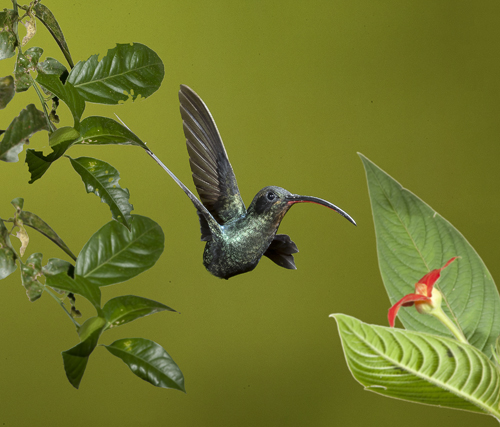
Green Hermit, one a dozen or more hummingbirds we photographed
This was the fourth time we've led a Photo Tour to Costa Rica, and in many ways this was one of the very best. That's saying something, when you consider that a volcano east of the capital city of San Jose erupted and spewed volcanic ash over the city, causing one of our participants to miss a flight as the airport was closed. But that's nothing! After we left our first lodge near hurricane force winds knocked down a tree which broke through the roof of the lodge, one room from where Mary and I had occupied. Next, at our second lodge, it rained off-and-on every day and night, and eventually the San Carlos River flooded, backing up feeder streams that eventually closed the road leading to our next destination. Although we planned to leave early because of the weather, we were delayed, and ended up leaving as we originally had planned. Dodging these environmental bullets was interesting, but didn't affect our shoot in the least.
In fact, the overcast skies most days really added to the shooting. Hummingbirds feed voraciously when it is cold and wet and dark, as on sunny days insects are active, and flowers pump out nectar via photosynthesis, so the birds don't need to visit our sugar feeders. Accordingly, our feeders were pretty active for virtually every shoot.
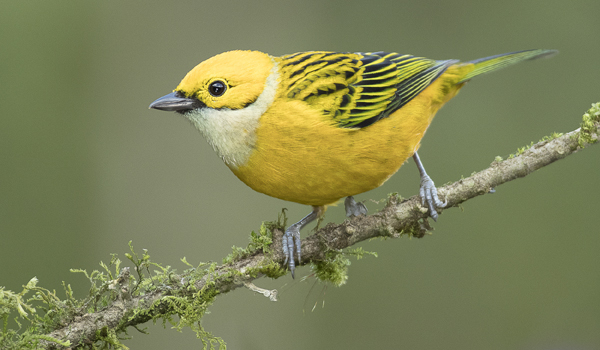
Silver-throated Tanager
All of our participants were 'veterans' of previous trips, so all were good friends and the camaraderie and interesting conversations made for a very pleasant time. We visited one new location, for the Resplendent Quetzal, one of the world's most spectacular birds. We saw several of this interesting bird, and managed some decent shots, although my appetite for getting even better shots has certainly been whetted. We'll be visiting this location again on our next tour, in early 2019.
I'll apologize in advance for not naming the exact location of the lodges we visited. For those who did the trip, they know where we were, of course, but for those who did not, I'm honoring the request of my outfitter who has scouted out many of these locations and, quite frankly, would like to benefit from his hard work. Not naming these lodges does not affect the content of this report, which will still give you a great idea of what you too can photograph if you join us in 2019.
If you're interested in 2019 Please contact us immediately so that you can get onto our 'first contact' list. I hope that this diverse portfolio gives you some idea of what you, too, will be shooting. Mary and I barely scratched the surface at some locales, for while our participants were shooting more images we were working on getting the hummingbird sets or the bat setup ready, and other odds and ends. The shooting productivity here is truly phenomenal.
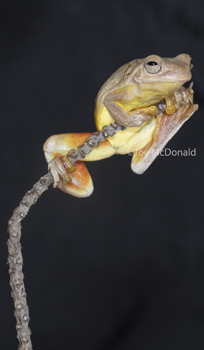
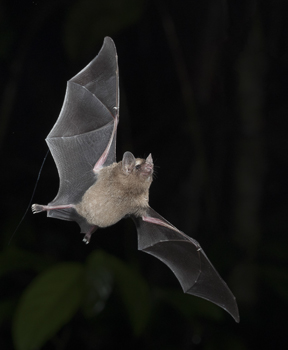
A swamp treefrog from our reptile shoot and a Pallas Long-tongued Bat from our bat shoot!
I must say that one of the highlights of this trip for Mary and I was when we reviewed the trip on our last evening, and everyone gave their highlights. We really appreciated that several participants had as their favorite shot or experience some of the setups or shoots we arranged, and they commented upon the amount of work that was involved. We really, really appreciated that, as sometimes participants just don't realize that no matter how smoothly and successful a trip is, it doesn't just happen. Work is involved, and lots of it. So thank you again, gang, we appreciated your comments.
So what work is involved? Most of our five duffle bags of luggage involved equipment, not clothes! Although our outfitter supplied most of the lightstands we needed, we still carried 3 ourselves. We also had 6 Super Clamps, 5 Articulating Arms, 5 Wimberley Plamps, six aluminum frames for backgrounds, 10 different backgrounds, 14 electronic flashes, 2 Range IRs, 1 Sabre, hard-wiring cable for a bat set up, 6 Phottix Transmitters, 12 Phottix Receivers, 3 tube hummingbird feeders, 3 bulb hummingbird feeders, and ... I'm sure I'm forgetting something!
All that said, here's the trip report. I hope you'll enjoy it!
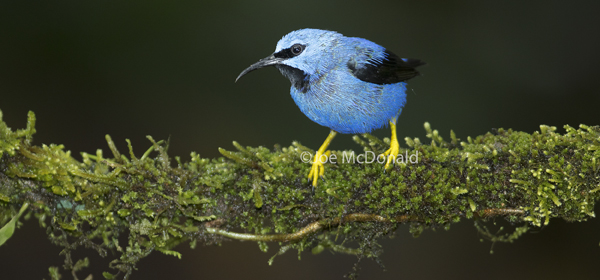
Day 1-San Jose
Most of us arrived today, a full day before the formal start of the tour, and fortunately we did so. Weather, in the Seattle area, closed in the following day, and in San Jose, Costa Rica …..
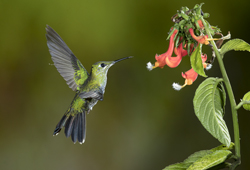 Day 2-San Jose
Day 2-San Jose
We awoke to sunny skies and a strange brownish gloom to the east. Later, we learned that a volcano in the eastern mountains was erupting, and winds blowing westward were carrying ash. Our first clue was in finding that the hotel’s swimming pool was temporarily closed because of volcanic ash. We wondered, ‘what ash?’ Soon, we saw it, as a fine covering of ash on the windows of the parked cars in the hotel’s lot, and the stinging sensation we had in our eyes from the fine, gritty material. The San Jose airport was closed because of the ash, and one of our participants was marooned in North Carolina because of it. We had our orientation meeting and a group dinner that evening, in preparation for our departure to our first stop tomorrow.
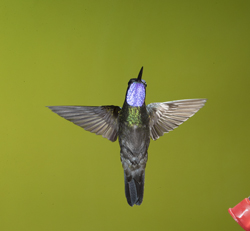 Day 3-Our first lodge
Day 3-Our first lodge
We left at 8 for a four hour drive to our first destination where we’d shoot hummingbirds. The countryside was beautiful, with rugged hills alternately covered in second-growth, jungle-like forests or in vivid green pastures, outlined with treelines dotted with massive, skeletal trees covered in bromeliads and mosses. We arrived at the lodge shortly before lunch, and soon after lunch began setting up our hummingbird sets. By 2PM we were ready, and we began the shoot. At least six species were photographed, including very cooperative Green Hermits, a species that has frustrated me in the past. This large, curve-billed Hummingbird has a long, tapering tail, and some years they only visit a hummingbird set infrequently. This year, they were extremely cooperative. We ended at 5PM, with the tropical darkness settling soon afterwards, but enjoying a great start.
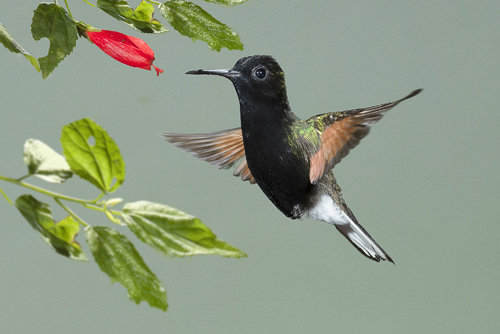
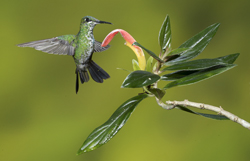 Day 4-Our first lodge and hummingbird field trip
Day 4-Our first lodge and hummingbird field trip
After breakfast we packed up and headed down the mountain to a new location where, under the protection of a covered dining area, we set up our feeders. We’ve used this spot on past shoots, but this year we were required to set up in an area a bit removed from where the restaurant has their feeders. I was worried that the birds might be fixated on the original spots and that our shooting would be slow, or difficult, but I needn’t have worried. Soon after setting up the feeders started getting activity, and the shoot went extremely well. Oddly, one hummingbird, the Black-bellied Hummingbird, is present at our lodge as well, but there it doesn’t visit the feeders. Instead, it only feeds upon the small blue flowers that line pencil-thin stalks, but here, the feeders are part of the bird’s trapline circuit. Other good birds included the White-bellied Mountain Gem Hummingbird, more Violet Sabre-Wings, and Rufous-tailed Hummingbird. In total, we had six or seven species visiting the feeder. A complete list will conclude this report.
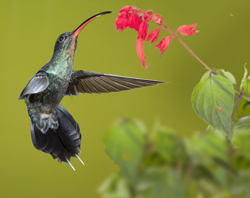
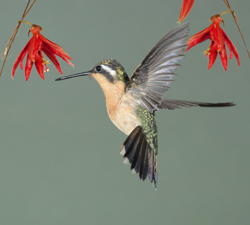
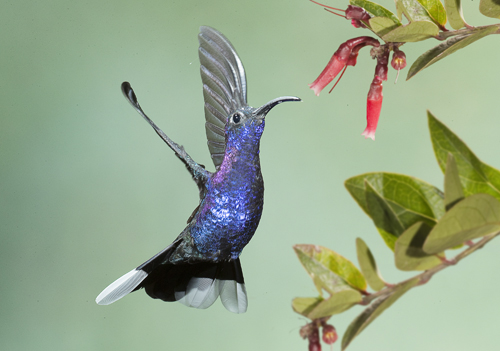
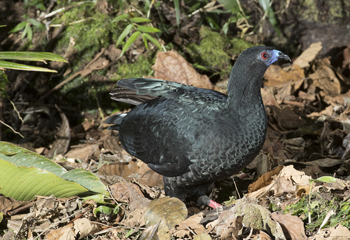 Day 5. Our first lodge
Day 5. Our first lodge
The day dawned clear and bright, and for almost the entire day we had blue skies and warm temperatures. I was worried that with the sunlight photosynthesis and nectar production, and insect activity, would be so great that the hummingbirds would only infrequently visit our feeders. That didn’t happen, and the day was extremely productive. In the afternoon, once the birds were homed in on our feeders, we divided everyone into teams of two where one photographer would shoot while the other replenished the sugar water in the flowers we used as props. This worked wonderfully, keeping everyone busy while they waited their turn, and the shooting was extremely productive.
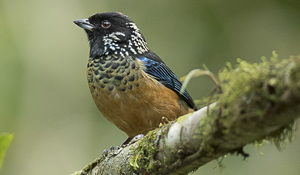
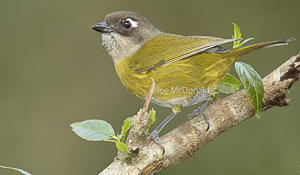
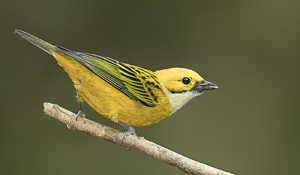 I set up some perches at the bird feeder and we did well with Silver-throated Tanager, Speckled Cheeked Tanager, and a Bush-Tanager. Later, as clouds began to build, Jose’ and I set up a jungle set in hopes of photographing the nocturnal Paca (a beagle-sized rodent). I started with an unattractive grassy lawn, but with leaves, logs, and palm fronds we had ourselves a jungle. I had transmitters for everyone to trigger the four flash setup, and then we waited. Eventually the Paca arrived, but in contrast to other years, when it was fed closer to the hummingbird sets, these large mammals were somewhat skittish and only remained for short periods. Mary orchestrated the shooting order, going down the line of photographers and tapping a shoulder to indicate it was their turn, and in this way we didn’t waste flash power or try to compete with each other. It began to rain, but fortunately it was a light one, and between breaks for dinner, we had about five sessions with the Paca. Soon after we quit it began to rain heavily, and through the night it stormed.
I set up some perches at the bird feeder and we did well with Silver-throated Tanager, Speckled Cheeked Tanager, and a Bush-Tanager. Later, as clouds began to build, Jose’ and I set up a jungle set in hopes of photographing the nocturnal Paca (a beagle-sized rodent). I started with an unattractive grassy lawn, but with leaves, logs, and palm fronds we had ourselves a jungle. I had transmitters for everyone to trigger the four flash setup, and then we waited. Eventually the Paca arrived, but in contrast to other years, when it was fed closer to the hummingbird sets, these large mammals were somewhat skittish and only remained for short periods. Mary orchestrated the shooting order, going down the line of photographers and tapping a shoulder to indicate it was their turn, and in this way we didn’t waste flash power or try to compete with each other. It began to rain, but fortunately it was a light one, and between breaks for dinner, we had about five sessions with the Paca. Soon after we quit it began to rain heavily, and through the night it stormed.
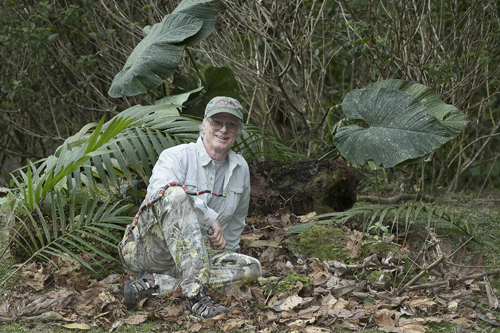
I'm sitting on what was a bare lawn, which I transformed into a mini-jungle in preparation for shooting the uncommonly seen, nocturnal Paca - a nearly beagle-sized rodent. The coral snake on my knee is a rubber toy, but it did provoke some scares and jokes with members of the lodges' various staffs, and my poor guide!
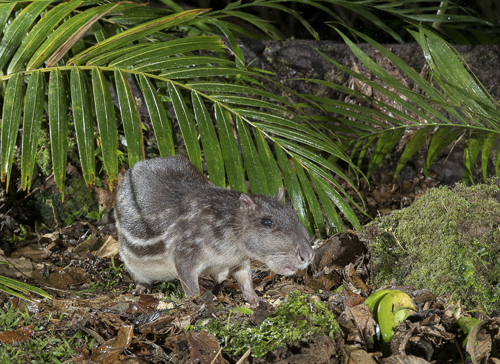
Day 6. First Lodge to the second, near the Nicaraguan border
It was still raining at dawn, sometimes pouring, and as we headed to a ranch for our first stop, where we hoped to photograph Macaws in flight, our prospects 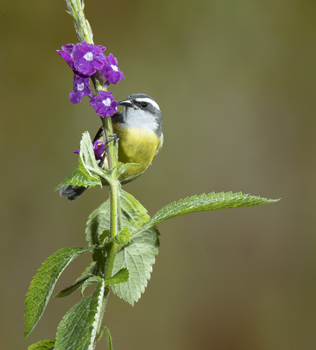 looked dismal. When we arrived at the ranch it was still pouring, and I wondered if we should just continue on and write-off this stop. Fortunately, we had a lunch voucher for here, and the ranch had the food bought, so we were socially obligated in staying, at least for an early lunch. And then I saw the Capuchin Monkeys!
looked dismal. When we arrived at the ranch it was still pouring, and I wondered if we should just continue on and write-off this stop. Fortunately, we had a lunch voucher for here, and the ranch had the food bought, so we were socially obligated in staying, at least for an early lunch. And then I saw the Capuchin Monkeys!
At first there was only one, and I was the only one to head out into the rain to try to photograph the monkey, which remained for only a few shots before scampering off. Later, it returned, and in distant trees I saw some more, and I asked our guide if the ranch owner feeds them. He did, and soon he was tossing peanuts beneath a tree, and the Monkeys came running in. Mary and I shot over 2,000 frames between us, of Capuchin Monkeys standing, sitting in trees, with babies on their back, running … I’ve never photographed this species before and the shooting was great. The first session was marred by our lenses constantly fogging, as we had traveled from the cool highlands to the hot and humid lowlands, but eventually our lenses cleared and the shooting was just wonderful.
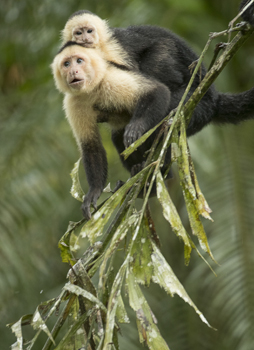
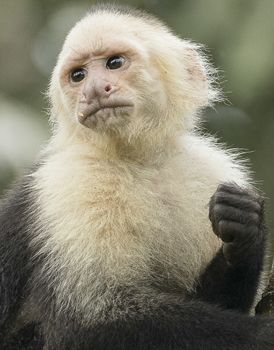
The owner also called in his huge flock of Scarlet and Green Macaws, providing everyone with two sessions – one with the birds somewhat bedraggled with the rain, and later, in wonderful light and with dry, perfect plumage. I had passed on that shoot until the temptation was too great, where upon I ran for my gear, set up, and was about to shoot just as the birds flew off. Minutes later the skies opened up again, and we left the ranch, after a great lunch, in more rain.
Northern Costa Rica, our next stop, had had rain, but it was dry when we arrived, and the management quickly erected some wonderful perches for our shooting. In two hours we photographed Keel-billed Toucans, Collared Aracari, Oropendolas, Honeycreepers, Dacnis, and several Tanagers. At dinner the weather returned, and through dinner and the late evening it periodically poured.
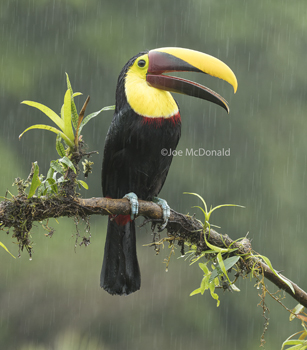
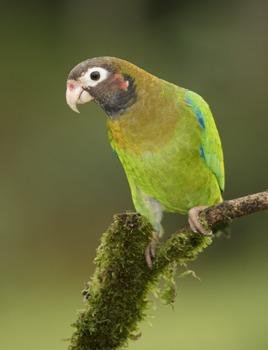
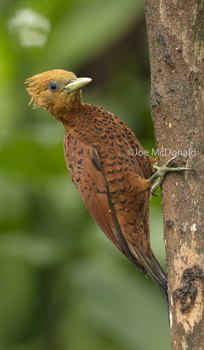
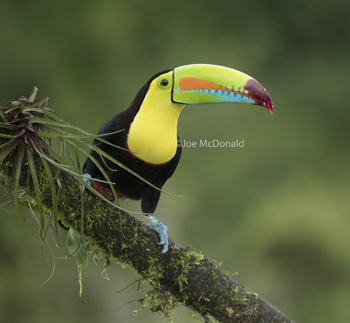
Day 7. Second Lodge
It rained during the night, sometimes in driving blasts that suggested a tropical storm. Prior to breakfast, most of us gathered on the covered porch to photograph Black-mandible Toucans, Keel-billed Toucans, Chestnut collared Aracaris, Golden Hooded Tanagers, three species of Honeycreeper, Brown-hooded Parrots, and a few other species.
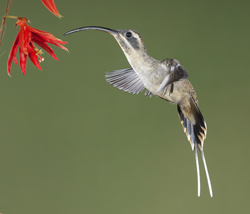
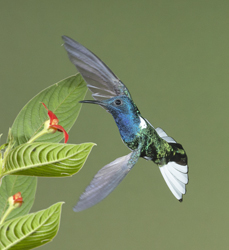
After breakfast, Mary, Jose’, and I headed to the manager’s hours to set up for a morning shoot where everyone photographed hummingbirds and a variety of songbirds. The hummingbird activity was incredible, with five new species for the group, including more White-necked Jacobins than I’ve ever seen before, and several opportunities for Striped Hermits. At the songbird locale, Honeycreepers, Kiskadees, Orange-chinned Parakeets, two species of Oropendolas, and two woodpeckers visited.
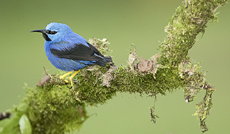
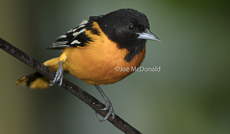
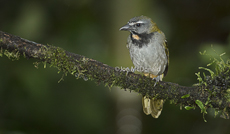
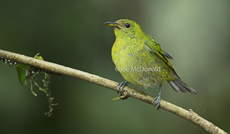
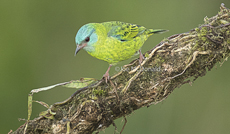
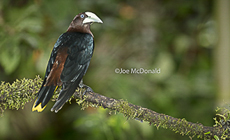
In the afternoon, we switched groups, with those who didn’t go in the morning doing so in the afternoon. Meanwhile, I spent the next several hours of the afternoon carrying equipment into the forest for a Bat shoot. As I began to set up, my guide told me that we had a problem. The lodge was now charging a fee to photograph the bats, ranging from $65 for one, or $35 per person for a group. Considering the lodge offered NOTHING, no lights, light stands, etc., this was ridiculous, but doubly so, since I was the very first photo tour to offer bat photography here. I told the manager that if anything, they should be paying me a commission! I was later told that other photographers claim to have started this bat shooting, which, to me, is truly annoying, as it simply isn’t true. The manager and my guide didn’t name names … fortunately.
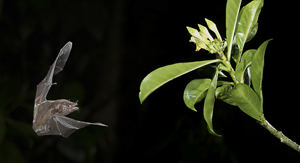
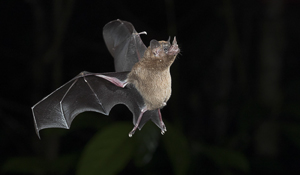
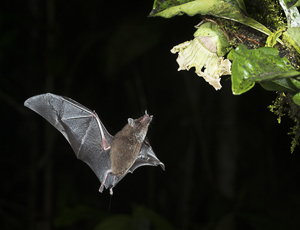 At any rate, when everyone was finished with their afternoon bird shooting we headed into the jungle so that everyone would have an idea of the conditions, working distances, and appropriate lenses. At 6PM, just at dark, we returned, and began shooting, using a flower as our bait. At 6:30 we had to leave for dinner, so we left our cameras running, filming the bats as they visited a feeder. After dinner, we returned, and this time finished the shoot by catching the bats as they visited the flowers we provided. Although we all shot over 899 images, with fierce culling I dropped this to about 200 images – which I’ll later cull to the best 30 or so.
At any rate, when everyone was finished with their afternoon bird shooting we headed into the jungle so that everyone would have an idea of the conditions, working distances, and appropriate lenses. At 6PM, just at dark, we returned, and began shooting, using a flower as our bait. At 6:30 we had to leave for dinner, so we left our cameras running, filming the bats as they visited a feeder. After dinner, we returned, and this time finished the shoot by catching the bats as they visited the flowers we provided. Although we all shot over 899 images, with fierce culling I dropped this to about 200 images – which I’ll later cull to the best 30 or so.
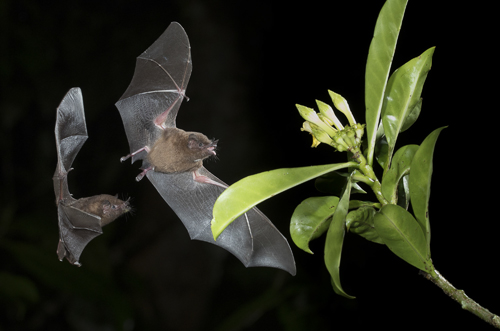
Day 8. Second Lodge
We followed a similar schedule today, with the last group going to the manager’s house for shooting while the others stayed around the lodge. A troop of Coatimundis raided the bird feeders during the morning session. In the afternoon, several in the group returned to the manager’s place for another round with the hummingbirds and songbirds, while Rick, Michael, and I tried our luck with the King
Vultures at a special blind. We were not successful with that species, but did get some interesting shots of the Crested Caracara.
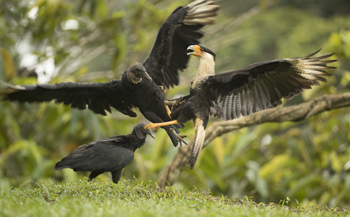
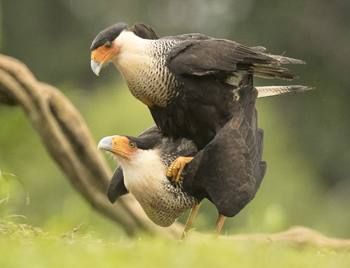
That evening, Senor’ Lagarto took the group on a short hike for Spectacles Caiman. Oddly, he calls to the Caiman in German, and the Caimans crawl out of the water and sit placidly, waiting for a hunk of chicken he provides. The guide was entertaining, and the hike was fun.

Day 8. To Arenal
We had planned on spending the morning shooting at the second lodge, and for a few of us revisiting the Vulture blind, but it rained heavily during the night. Trees fell and cut the power, and the San Carlos River backed up feeder streams and flooded the road. Hoping to avoid a catastrophe, we decided to leave right after breakfast. We didn’t. The road was flooded and we waited on the covered porch for word that we could travel.
During that time, I once again reviewed flash, fill-flash, and ambient light/flash settings in preparation for the following day’s shoot (provided we got out). We had an early lunch, and afterwards got a call that the road was clear and we headed out. The road wasn’t clear – it was still flooded, but we only had to wait 30 minutes until the water dropped sufficiently for us to safely cross. Other lodge guests, hoping to reach another lodge by mid-afternoon, had left right after breakfast, and had bee marooned here, waiting, for six hours!
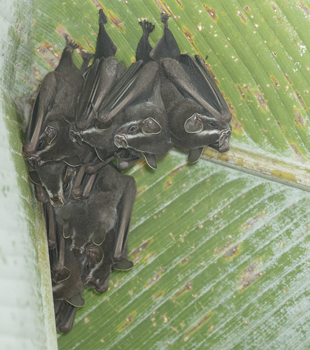 We drove through the dropping water and continued towards Arenal. Along the way, with only 1.5 hours of afternoon light remaining, we stopped at a small wildlife park where we photographed two species of Mot-mot, Boat-billed Herons, and Three-toed Sloths. I was determined that this year I’d photograph the sloth, as I’ve always missed it, and I did so once again. Susan and Michael got great shots, but by the time I arrived it had curled up and went to sleep – for the remainder of the day. I was frustrated once more!
We drove through the dropping water and continued towards Arenal. Along the way, with only 1.5 hours of afternoon light remaining, we stopped at a small wildlife park where we photographed two species of Mot-mot, Boat-billed Herons, and Three-toed Sloths. I was determined that this year I’d photograph the sloth, as I’ve always missed it, and I did so once again. Susan and Michael got great shots, but by the time I arrived it had curled up and went to sleep – for the remainder of the day. I was frustrated once more!
We did find a very open roost for Common Tent-making Bats, who chew into the stem of a banana leaf until the leave collapses on itself, forming a fold or 'tent' that the bats use as shelter.
At the entrance to this wildlife park various birds visit the feeder, and just in the limited time we had we did quite well with several species.
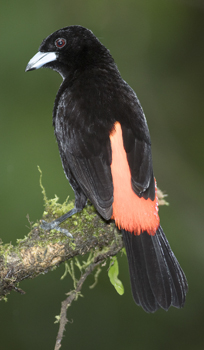
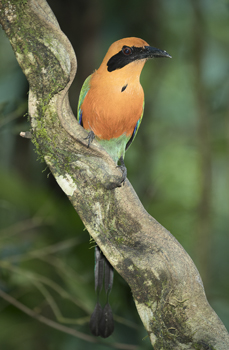
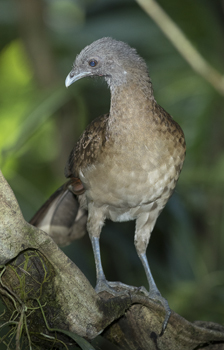
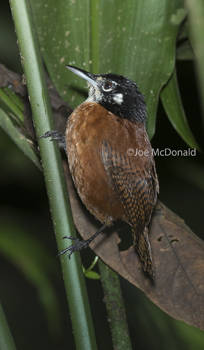
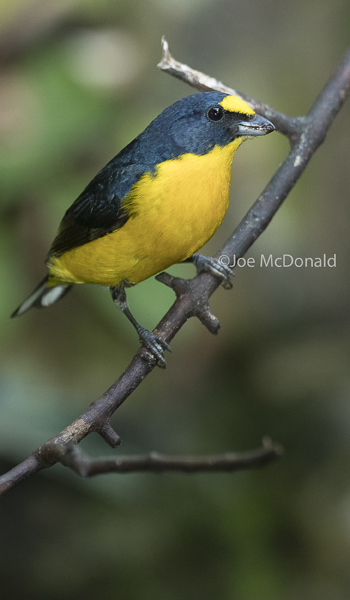
We continued on to our lodge, where I spotted a Coral Snake or its mimic crossing the road. Central American Coral Snakes and their mimics do not follow the same color rules as those do in the US, so we safely watched the snake cross the road and travel into the leaf litter. Later, we determined it was a true Coral Snake, so it was prudent that I simply watched!
Day 9. Arenal
Today we spent an extremely productive day at the local reptile zoo where we photographed over 25 different subjects, representing about 21 different species. The subjects ranged from the fragile-looking and transparent Glass Frog to the world’s largest pit-viper, the Bushmaster. It was a great day!
Here's a portfolio of most of the subjects we shot at the reptile zoo, one of my favorite locations in Costa Rica and run by a family that can't do enough to make our shoots extremely productive.
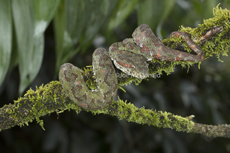
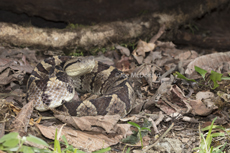
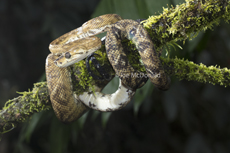
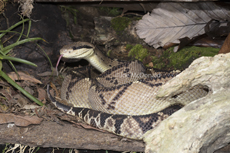

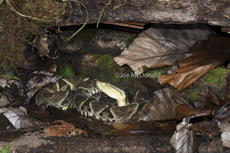
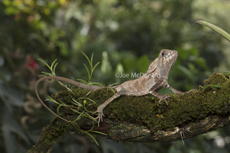
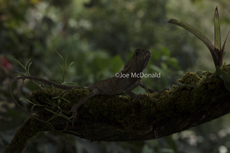
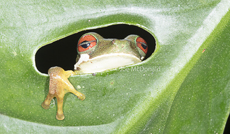
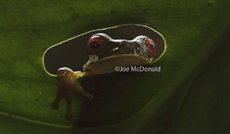
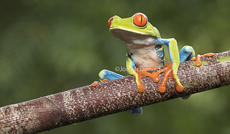
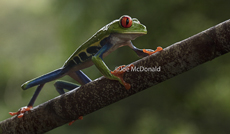
For days before this reptile shoot I stressed that everyone practice using their flash in a full and fill-in mode so that participants could control the 'look' they wanted on the backgrounds, as some subjects were nocturnal and others were diurnal. The above images show the difference when flash wasn't added (right side), although in the case of the two frog shots I did post-processing in RAW to bring out detail that originally didn't seem to be there! Although I often felt like I was nagging, the results were worth it -- everyone got great shots that far exceeded what they'd have shot if they just did TTL and hoped for the best!
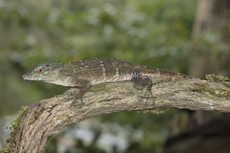
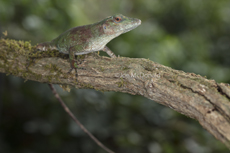
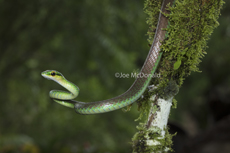
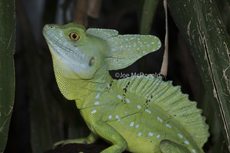
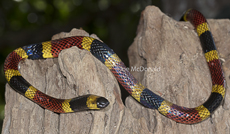
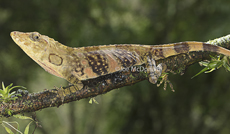
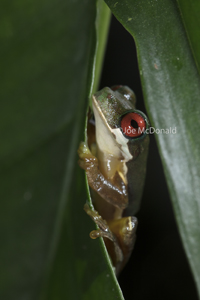
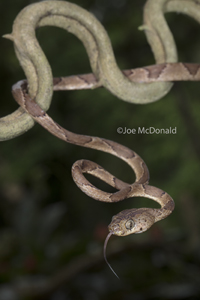
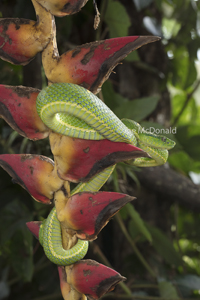
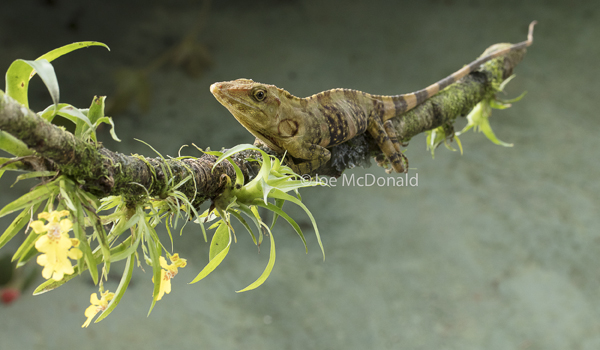
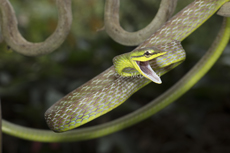
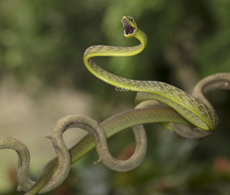
Day 10. Arenal to the Quetzals
We left by 8AM for a long, five hour or more drive south, passing through the heavy traffic of San Jose’ as we continued southward. It rained as we left Arenal, then cleared wonderfully, but as we approached the mountainous highlands in Quetzal territory, cloud forest land, the skies once again disappeared. There was an incredible amount of hummingbirds around the feeders, and hoping to shoot hummingbirds the following day Mary and I started working on a setup for the group. By the end of a few hours work we had the birds conditioned to our feeders and flowers and we were ready to go, expecting to shoot on the following day.
Meanwhile, it rained heavily, and some stayed on the covered porch to shoot the Fiery-throat Hummingbird - (fiery is not a typo, although the bird has a 'firey' throat, the guides, perhaps honoring an ancient misspelling, call this a 'fiery'), Blue Violet-ear, Magnificent, and Volcano Hummingbirds that congregated around the feeders outside the dining area. It grew surprisingly cold and damp. That evening, I reviewed the PDF with our participants on adding flowers to a hummingbird shot.
.jpg)
Day 11. Quetzals
We left the lodge at 5:30AM for Quetzals, driving about 20 minutes to a mixed forest and field farmland where a wild avocado tree was producing fruit and where as many as five male Quetzals fly in to visit. The morning started cold, dark, and damp, but as soon as we arrived the farm owner pointed out a female Quetzal perched in a tree. The light was low and the shooting marginal, but we were all excited about seeing our first Quetzal. We stayed nearly four hours, and 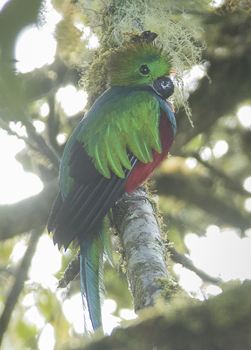 fortunately several males arrived, the males sporting long, trailing tail feathers that were once prized by Aztec royalty. We got some very clear shots, although not as close as we’d like. By 9 we returned to the lodge for breakfast, and at 10:15 we headed back out for another try, but the skies cleared and the light was terrible, all contrast. We left about an hour later, planning to return in the afternoon.
fortunately several males arrived, the males sporting long, trailing tail feathers that were once prized by Aztec royalty. We got some very clear shots, although not as close as we’d like. By 9 we returned to the lodge for breakfast, and at 10:15 we headed back out for another try, but the skies cleared and the light was terrible, all contrast. We left about an hour later, planning to return in the afternoon.
Left: Terrible back lighting, but here's a Quetzal about to swallow a wild avocado fruit.
After lunch, around 1:30PM, we returned for the Quetzal. A male was present as we arrived but it was in deep shade and facing away from us. Later, males flew in twice, as did a female that Mary caught in flight as it flew off, carrying an avocado fruit. The Quetzal shooting was very slow and unproductive, but we had Flame-throated Warbler, Collared Redstart, and Ochraceous Wren – and most of us had some nice shots of these rare songbirds. We had some near misses with the male Quetzal, but the bird always flew off before we could get into position. By 4:45 with the activity nil we headed back to the lodge.
Our plans to photograph hummingbirds at a feeder did not pan out today because of the full day spent chasing Quetzals!
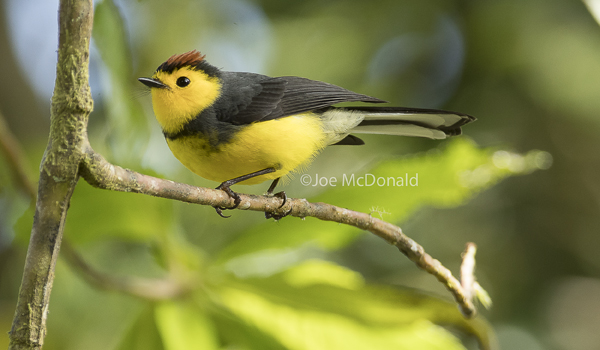
Two trophy songbirds - Collared Redstart (top); Flame-throated Warbler (below)
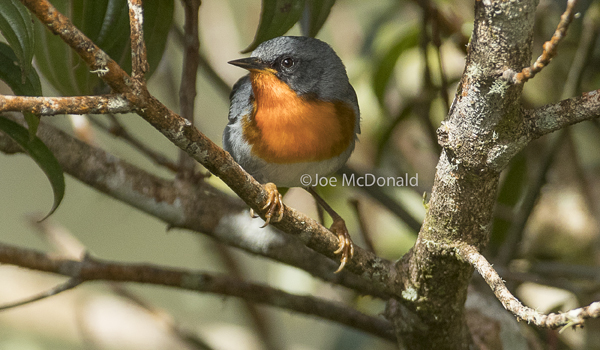
Day 12. Quetzals to San Jose
We froze during the night. Our lodge, which is wonderful for Quetzals and has wonderful grounds and shooting opportunities for hummingbirds, has cabins that are completely uninsulated, and at nearly 9,000 feet at night, under clear skies, the cabins are frigid. Everyone was cold during the night, and we awoke to clear skies for our last full morning of shooting.
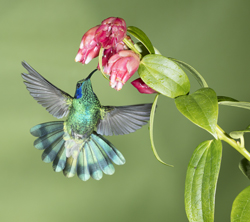
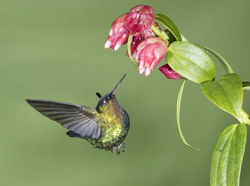
Green Violet-ear Hummingbird, left; Fiery-throated Hummingbird, right and below.
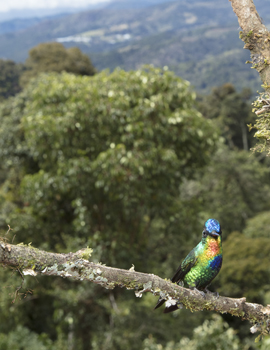 Mary and I set up two feeders and flashes for the shoot, and everyone had Green Violet-eared, Firery-throat, and Magnificent Hummingbirds, with tiny Volcano Hummers flitting about and teasing us – and occasionally coming in to the feeders. The shoot went quite well, as I expected it to. Oddly, our guide seemed reluctant for us to set up a high-speed flash system here, saying that the Fiery-throat's gorget won't show up with flash and that we would only have one morning to shoot. Well, that was enough time for everyone to get great images, and it was a wonderful way to end the shoot!
Mary and I set up two feeders and flashes for the shoot, and everyone had Green Violet-eared, Firery-throat, and Magnificent Hummingbirds, with tiny Volcano Hummers flitting about and teasing us – and occasionally coming in to the feeders. The shoot went quite well, as I expected it to. Oddly, our guide seemed reluctant for us to set up a high-speed flash system here, saying that the Fiery-throat's gorget won't show up with flash and that we would only have one morning to shoot. Well, that was enough time for everyone to get great images, and it was a wonderful way to end the shoot!
At noon we concluded, had lunch, and headed back to San Jose.
That evening at our final dinner we reviewed the trip highlights and shoots, with highlights and favorite photos and subjects including: the bats, the Capuchin Monkeys, the Quetzal, the Macaws, Paca, the various Hummingbirds, the Eyelash Viper, the Treefrogs, the Sloth, and several others. It was a great recap and review of a fantastic 12 days of photography, probably the most diverse and rewarding we’ve had in Costa Rica.
For lenses, I used the Canon 200-400mm with 1.4X converter for most of my shooting. Mary used her 100-400mm. For Macro at the zoo we used a 180mm macro (Mary), a 100-400 (Mary), or a 105mm with Canon Twin Lights (Joe) for most of the work. We both carried a 24-105mm, which because of the weather we didn't have many opportunities to use for scenics, which I missed.
I also carried along my trusty Range IRs and a Sabre for the bat shooting. I was hoping to use the waterproof Sabre on some jungle trails, but the rain was so bad that the trails were too soggy to slog through. Hopefully, next time!
I used 64 and 32gb Hoodman Cards, which are incredibly fast, somewhat essential when shooting fast action -- and we had plenty.
Refer to our BROCHURE to get an idea of next trip! The brochure (as of 1-21-2017)may not be completely updated for 2019, but the itinerary will be similar. The images in this report, and the text should give you a great idea of what you, too, can expect.
Trip Report:
The Hummingbirds
and Wildlife of
Costa Rica
Photo Tour
2017

Green Hermit, one a dozen or more hummingbirds we photographed
This was the fourth time we've led a Photo Tour to Costa Rica, and in many ways this was one of the very best. That's saying something, when you consider that a volcano east of the capital city of San Jose erupted and spewed volcanic ash over the city, causing one of our participants to miss a flight as the airport was closed. But that's nothing! After we left our first lodge near hurricane force winds knocked down a tree which broke through the roof of the lodge, one room from where Mary and I had occupied. Next, at our second lodge, it rained off-and-on every day and night, and eventually the San Carlos River flooded, backing up feeder streams that eventually closed the road leading to our next destination. Although we planned to leave early because of the weather, we were delayed, and ended up leaving as we originally had planned. Dodging these environmental bullets was interesting, but didn't affect our shoot in the least.
In fact, the overcast skies most days really added to the shooting. Hummingbirds feed voraciously when it is cold and wet and dark, as on sunny days insects are active, and flowers pump out nectar via photosynthesis, so the birds don't need to visit our sugar feeders. Accordingly, our feeders were pretty active for virtually every shoot.

Silver-throated Tanager
All of our participants were 'veterans' of previous trips, so all were good friends and the camaraderie and interesting conversations made for a very pleasant time. We visited one new location, for the Resplendent Quetzal, one of the world's most spectacular birds. We saw several of this interesting bird, and managed some decent shots, although my appetite for getting even better shots has certainly been whetted. We'll be visiting this location again on our next tour, in early 2019.
I'll apologize in advance for not naming the exact location of the lodges we visited. For those who did the trip, they know where we were, of course, but for those who did not, I'm honoring the request of my outfitter who has scouted out many of these locations and, quite frankly, would like to benefit from his hard work. Not naming these lodges does not affect the content of this report, which will still give you a great idea of what you too can photograph if you join us in 2019.
If you're interested in 2019 Please contact us immediately so that you can get onto our 'first contact' list. I hope that this diverse portfolio gives you some idea of what you, too, will be shooting. Mary and I barely scratched the surface at some locales, for while our participants were shooting more images we were working on getting the hummingbird sets or the bat setup ready, and other odds and ends. The shooting productivity here is truly phenomenal.


A swamp treefrog from our reptile shoot and a Pallas Long-tongued Bat from our bat shoot!
I must say that one of the highlights of this trip for Mary and I was when we reviewed the trip on our last evening, and everyone gave their highlights. We really appreciated that several participants had as their favorite shot or experience some of the setups or shoots we arranged, and they commented upon the amount of work that was involved. We really, really appreciated that, as sometimes participants just don't realize that no matter how smoothly and successful a trip is, it doesn't just happen. Work is involved, and lots of it. So thank you again, gang, we appreciated your comments.
So what work is involved? Most of our five duffle bags of luggage involved equipment, not clothes! Although our outfitter supplied most of the lightstands we needed, we still carried 3 ourselves. We also had 6 Super Clamps, 5 Articulating Arms, 5 Wimberley Plamps, six aluminum frames for backgrounds, 10 different backgrounds, 14 electronic flashes, 2 Range IRs, 1 Sabre, hard-wiring cable for a bat set up, 6 Phottix Transmitters, 12 Phottix Receivers, 3 tube hummingbird feeders, 3 bulb hummingbird feeders, and ... I'm sure I'm forgetting something!
All that said, here's the trip report. I hope you'll enjoy it!

Day 1-San Jose
Most of us arrived today, a full day before the formal start of the tour, and fortunately we did so. Weather, in the Seattle area, closed in the following day, and in San Jose, Costa Rica …..
 Day 2-San Jose
Day 2-San Jose
We awoke to sunny skies and a strange brownish gloom to the east. Later, we learned that a volcano in the eastern mountains was erupting, and winds blowing westward were carrying ash. Our first clue was in finding that the hotel’s swimming pool was temporarily closed because of volcanic ash. We wondered, ‘what ash?’ Soon, we saw it, as a fine covering of ash on the windows of the parked cars in the hotel’s lot, and the stinging sensation we had in our eyes from the fine, gritty material. The San Jose airport was closed because of the ash, and one of our participants was marooned in North Carolina because of it. We had our orientation meeting and a group dinner that evening, in preparation for our departure to our first stop tomorrow.
 Day 3-Our first lodge
Day 3-Our first lodge
We left at 8 for a four hour drive to our first destination where we’d shoot hummingbirds. The countryside was beautiful, with rugged hills alternately covered in second-growth, jungle-like forests or in vivid green pastures, outlined with treelines dotted with massive, skeletal trees covered in bromeliads and mosses. We arrived at the lodge shortly before lunch, and soon after lunch began setting up our hummingbird sets. By 2PM we were ready, and we began the shoot. At least six species were photographed, including very cooperative Green Hermits, a species that has frustrated me in the past. This large, curve-billed Hummingbird has a long, tapering tail, and some years they only visit a hummingbird set infrequently. This year, they were extremely cooperative. We ended at 5PM, with the tropical darkness settling soon afterwards, but enjoying a great start.

 Day 4-Our first lodge and hummingbird field trip
Day 4-Our first lodge and hummingbird field trip
After breakfast we packed up and headed down the mountain to a new location where, under the protection of a covered dining area, we set up our feeders. We’ve used this spot on past shoots, but this year we were required to set up in an area a bit removed from where the restaurant has their feeders. I was worried that the birds might be fixated on the original spots and that our shooting would be slow, or difficult, but I needn’t have worried. Soon after setting up the feeders started getting activity, and the shoot went extremely well. Oddly, one hummingbird, the Black-bellied Hummingbird, is present at our lodge as well, but there it doesn’t visit the feeders. Instead, it only feeds upon the small blue flowers that line pencil-thin stalks, but here, the feeders are part of the bird’s trapline circuit. Other good birds included the White-bellied Mountain Gem Hummingbird, more Violet Sabre-Wings, and Rufous-tailed Hummingbird. In total, we had six or seven species visiting the feeder. A complete list will conclude this report.



 Day 5. Our first lodge
Day 5. Our first lodge
The day dawned clear and bright, and for almost the entire day we had blue skies and warm temperatures. I was worried that with the sunlight photosynthesis and nectar production, and insect activity, would be so great that the hummingbirds would only infrequently visit our feeders. That didn’t happen, and the day was extremely productive. In the afternoon, once the birds were homed in on our feeders, we divided everyone into teams of two where one photographer would shoot while the other replenished the sugar water in the flowers we used as props. This worked wonderfully, keeping everyone busy while they waited their turn, and the shooting was extremely productive.


 I set up some perches at the bird feeder and we did well with Silver-throated Tanager, Speckled Cheeked Tanager, and a Bush-Tanager. Later, as clouds began to build, Jose’ and I set up a jungle set in hopes of photographing the nocturnal Paca (a beagle-sized rodent). I started with an unattractive grassy lawn, but with leaves, logs, and palm fronds we had ourselves a jungle. I had transmitters for everyone to trigger the four flash setup, and then we waited. Eventually the Paca arrived, but in contrast to other years, when it was fed closer to the hummingbird sets, these large mammals were somewhat skittish and only remained for short periods. Mary orchestrated the shooting order, going down the line of photographers and tapping a shoulder to indicate it was their turn, and in this way we didn’t waste flash power or try to compete with each other. It began to rain, but fortunately it was a light one, and between breaks for dinner, we had about five sessions with the Paca. Soon after we quit it began to rain heavily, and through the night it stormed.
I set up some perches at the bird feeder and we did well with Silver-throated Tanager, Speckled Cheeked Tanager, and a Bush-Tanager. Later, as clouds began to build, Jose’ and I set up a jungle set in hopes of photographing the nocturnal Paca (a beagle-sized rodent). I started with an unattractive grassy lawn, but with leaves, logs, and palm fronds we had ourselves a jungle. I had transmitters for everyone to trigger the four flash setup, and then we waited. Eventually the Paca arrived, but in contrast to other years, when it was fed closer to the hummingbird sets, these large mammals were somewhat skittish and only remained for short periods. Mary orchestrated the shooting order, going down the line of photographers and tapping a shoulder to indicate it was their turn, and in this way we didn’t waste flash power or try to compete with each other. It began to rain, but fortunately it was a light one, and between breaks for dinner, we had about five sessions with the Paca. Soon after we quit it began to rain heavily, and through the night it stormed.

I'm sitting on what was a bare lawn, which I transformed into a mini-jungle in preparation for shooting the uncommonly seen, nocturnal Paca - a nearly beagle-sized rodent. The coral snake on my knee is a rubber toy, but it did provoke some scares and jokes with members of the lodges' various staffs, and my poor guide!

Day 6. First Lodge to the second, near the Nicaraguan border
It was still raining at dawn, sometimes pouring, and as we headed to a ranch for our first stop, where we hoped to photograph Macaws in flight, our prospects  looked dismal. When we arrived at the ranch it was still pouring, and I wondered if we should just continue on and write-off this stop. Fortunately, we had a lunch voucher for here, and the ranch had the food bought, so we were socially obligated in staying, at least for an early lunch. And then I saw the Capuchin Monkeys!
looked dismal. When we arrived at the ranch it was still pouring, and I wondered if we should just continue on and write-off this stop. Fortunately, we had a lunch voucher for here, and the ranch had the food bought, so we were socially obligated in staying, at least for an early lunch. And then I saw the Capuchin Monkeys!
At first there was only one, and I was the only one to head out into the rain to try to photograph the monkey, which remained for only a few shots before scampering off. Later, it returned, and in distant trees I saw some more, and I asked our guide if the ranch owner feeds them. He did, and soon he was tossing peanuts beneath a tree, and the Monkeys came running in. Mary and I shot over 2,000 frames between us, of Capuchin Monkeys standing, sitting in trees, with babies on their back, running … I’ve never photographed this species before and the shooting was great. The first session was marred by our lenses constantly fogging, as we had traveled from the cool highlands to the hot and humid lowlands, but eventually our lenses cleared and the shooting was just wonderful.


The owner also called in his huge flock of Scarlet and Green Macaws, providing everyone with two sessions – one with the birds somewhat bedraggled with the rain, and later, in wonderful light and with dry, perfect plumage. I had passed on that shoot until the temptation was too great, where upon I ran for my gear, set up, and was about to shoot just as the birds flew off. Minutes later the skies opened up again, and we left the ranch, after a great lunch, in more rain.
Northern Costa Rica, our next stop, had had rain, but it was dry when we arrived, and the management quickly erected some wonderful perches for our shooting. In two hours we photographed Keel-billed Toucans, Collared Aracari, Oropendolas, Honeycreepers, Dacnis, and several Tanagers. At dinner the weather returned, and through dinner and the late evening it periodically poured.




Day 7. Second Lodge
It rained during the night, sometimes in driving blasts that suggested a tropical storm. Prior to breakfast, most of us gathered on the covered porch to photograph Black-mandible Toucans, Keel-billed Toucans, Chestnut collared Aracaris, Golden Hooded Tanagers, three species of Honeycreeper, Brown-hooded Parrots, and a few other species.


After breakfast, Mary, Jose’, and I headed to the manager’s hours to set up for a morning shoot where everyone photographed hummingbirds and a variety of songbirds. The hummingbird activity was incredible, with five new species for the group, including more White-necked Jacobins than I’ve ever seen before, and several opportunities for Striped Hermits. At the songbird locale, Honeycreepers, Kiskadees, Orange-chinned Parakeets, two species of Oropendolas, and two woodpeckers visited.






In the afternoon, we switched groups, with those who didn’t go in the morning doing so in the afternoon. Meanwhile, I spent the next several hours of the afternoon carrying equipment into the forest for a Bat shoot. As I began to set up, my guide told me that we had a problem. The lodge was now charging a fee to photograph the bats, ranging from $65 for one, or $35 per person for a group. Considering the lodge offered NOTHING, no lights, light stands, etc., this was ridiculous, but doubly so, since I was the very first photo tour to offer bat photography here. I told the manager that if anything, they should be paying me a commission! I was later told that other photographers claim to have started this bat shooting, which, to me, is truly annoying, as it simply isn’t true. The manager and my guide didn’t name names … fortunately.


 At any rate, when everyone was finished with their afternoon bird shooting we headed into the jungle so that everyone would have an idea of the conditions, working distances, and appropriate lenses. At 6PM, just at dark, we returned, and began shooting, using a flower as our bait. At 6:30 we had to leave for dinner, so we left our cameras running, filming the bats as they visited a feeder. After dinner, we returned, and this time finished the shoot by catching the bats as they visited the flowers we provided. Although we all shot over 899 images, with fierce culling I dropped this to about 200 images – which I’ll later cull to the best 30 or so.
At any rate, when everyone was finished with their afternoon bird shooting we headed into the jungle so that everyone would have an idea of the conditions, working distances, and appropriate lenses. At 6PM, just at dark, we returned, and began shooting, using a flower as our bait. At 6:30 we had to leave for dinner, so we left our cameras running, filming the bats as they visited a feeder. After dinner, we returned, and this time finished the shoot by catching the bats as they visited the flowers we provided. Although we all shot over 899 images, with fierce culling I dropped this to about 200 images – which I’ll later cull to the best 30 or so.

Day 8. Second Lodge
We followed a similar schedule today, with the last group going to the manager’s house for shooting while the others stayed around the lodge. A troop of Coatimundis raided the bird feeders during the morning session. In the afternoon, several in the group returned to the manager’s place for another round with the hummingbirds and songbirds, while Rick, Michael, and I tried our luck with the King
Vultures at a special blind. We were not successful with that species, but did get some interesting shots of the Crested Caracara.


That evening, Senor’ Lagarto took the group on a short hike for Spectacles Caiman. Oddly, he calls to the Caiman in German, and the Caimans crawl out of the water and sit placidly, waiting for a hunk of chicken he provides. The guide was entertaining, and the hike was fun.

Day 8. To Arenal
We had planned on spending the morning shooting at the second lodge, and for a few of us revisiting the Vulture blind, but it rained heavily during the night. Trees fell and cut the power, and the San Carlos River backed up feeder streams and flooded the road. Hoping to avoid a catastrophe, we decided to leave right after breakfast. We didn’t. The road was flooded and we waited on the covered porch for word that we could travel.
During that time, I once again reviewed flash, fill-flash, and ambient light/flash settings in preparation for the following day’s shoot (provided we got out). We had an early lunch, and afterwards got a call that the road was clear and we headed out. The road wasn’t clear – it was still flooded, but we only had to wait 30 minutes until the water dropped sufficiently for us to safely cross. Other lodge guests, hoping to reach another lodge by mid-afternoon, had left right after breakfast, and had bee marooned here, waiting, for six hours!
 We drove through the dropping water and continued towards Arenal. Along the way, with only 1.5 hours of afternoon light remaining, we stopped at a small wildlife park where we photographed two species of Mot-mot, Boat-billed Herons, and Three-toed Sloths. I was determined that this year I’d photograph the sloth, as I’ve always missed it, and I did so once again. Susan and Michael got great shots, but by the time I arrived it had curled up and went to sleep – for the remainder of the day. I was frustrated once more!
We drove through the dropping water and continued towards Arenal. Along the way, with only 1.5 hours of afternoon light remaining, we stopped at a small wildlife park where we photographed two species of Mot-mot, Boat-billed Herons, and Three-toed Sloths. I was determined that this year I’d photograph the sloth, as I’ve always missed it, and I did so once again. Susan and Michael got great shots, but by the time I arrived it had curled up and went to sleep – for the remainder of the day. I was frustrated once more!
We did find a very open roost for Common Tent-making Bats, who chew into the stem of a banana leaf until the leave collapses on itself, forming a fold or 'tent' that the bats use as shelter.
At the entrance to this wildlife park various birds visit the feeder, and just in the limited time we had we did quite well with several species.





We continued on to our lodge, where I spotted a Coral Snake or its mimic crossing the road. Central American Coral Snakes and their mimics do not follow the same color rules as those do in the US, so we safely watched the snake cross the road and travel into the leaf litter. Later, we determined it was a true Coral Snake, so it was prudent that I simply watched!
Day 9. Arenal
Today we spent an extremely productive day at the local reptile zoo where we photographed over 25 different subjects, representing about 21 different species. The subjects ranged from the fragile-looking and transparent Glass Frog to the world’s largest pit-viper, the Bushmaster. It was a great day!
Here's a portfolio of most of the subjects we shot at the reptile zoo, one of my favorite locations in Costa Rica and run by a family that can't do enough to make our shoots extremely productive.












For days before this reptile shoot I stressed that everyone practice using their flash in a full and fill-in mode so that participants could control the 'look' they wanted on the backgrounds, as some subjects were nocturnal and others were diurnal. The above images show the difference when flash wasn't added (right side), although in the case of the two frog shots I did post-processing in RAW to bring out detail that originally didn't seem to be there! Although I often felt like I was nagging, the results were worth it -- everyone got great shots that far exceeded what they'd have shot if they just did TTL and hoped for the best!












Day 10. Arenal to the Quetzals
We left by 8AM for a long, five hour or more drive south, passing through the heavy traffic of San Jose’ as we continued southward. It rained as we left Arenal, then cleared wonderfully, but as we approached the mountainous highlands in Quetzal territory, cloud forest land, the skies once again disappeared. There was an incredible amount of hummingbirds around the feeders, and hoping to shoot hummingbirds the following day Mary and I started working on a setup for the group. By the end of a few hours work we had the birds conditioned to our feeders and flowers and we were ready to go, expecting to shoot on the following day.
Meanwhile, it rained heavily, and some stayed on the covered porch to shoot the Fiery-throat Hummingbird - (fiery is not a typo, although the bird has a 'firey' throat, the guides, perhaps honoring an ancient misspelling, call this a 'fiery'), Blue Violet-ear, Magnificent, and Volcano Hummingbirds that congregated around the feeders outside the dining area. It grew surprisingly cold and damp. That evening, I reviewed the PDF with our participants on adding flowers to a hummingbird shot.
.jpg)
Day 11. Quetzals
We left the lodge at 5:30AM for Quetzals, driving about 20 minutes to a mixed forest and field farmland where a wild avocado tree was producing fruit and where as many as five male Quetzals fly in to visit. The morning started cold, dark, and damp, but as soon as we arrived the farm owner pointed out a female Quetzal perched in a tree. The light was low and the shooting marginal, but we were all excited about seeing our first Quetzal. We stayed nearly four hours, and  fortunately several males arrived, the males sporting long, trailing tail feathers that were once prized by Aztec royalty. We got some very clear shots, although not as close as we’d like. By 9 we returned to the lodge for breakfast, and at 10:15 we headed back out for another try, but the skies cleared and the light was terrible, all contrast. We left about an hour later, planning to return in the afternoon.
fortunately several males arrived, the males sporting long, trailing tail feathers that were once prized by Aztec royalty. We got some very clear shots, although not as close as we’d like. By 9 we returned to the lodge for breakfast, and at 10:15 we headed back out for another try, but the skies cleared and the light was terrible, all contrast. We left about an hour later, planning to return in the afternoon.
Left: Terrible back lighting, but here's a Quetzal about to swallow a wild avocado fruit.
After lunch, around 1:30PM, we returned for the Quetzal. A male was present as we arrived but it was in deep shade and facing away from us. Later, males flew in twice, as did a female that Mary caught in flight as it flew off, carrying an avocado fruit. The Quetzal shooting was very slow and unproductive, but we had Flame-throated Warbler, Collared Redstart, and Ochraceous Wren – and most of us had some nice shots of these rare songbirds. We had some near misses with the male Quetzal, but the bird always flew off before we could get into position. By 4:45 with the activity nil we headed back to the lodge.
Our plans to photograph hummingbirds at a feeder did not pan out today because of the full day spent chasing Quetzals!

Two trophy songbirds - Collared Redstart (top); Flame-throated Warbler (below)

Day 12. Quetzals to San Jose
We froze during the night. Our lodge, which is wonderful for Quetzals and has wonderful grounds and shooting opportunities for hummingbirds, has cabins that are completely uninsulated, and at nearly 9,000 feet at night, under clear skies, the cabins are frigid. Everyone was cold during the night, and we awoke to clear skies for our last full morning of shooting.


Green Violet-ear Hummingbird, left; Fiery-throated Hummingbird, right and below.
 Mary and I set up two feeders and flashes for the shoot, and everyone had Green Violet-eared, Firery-throat, and Magnificent Hummingbirds, with tiny Volcano Hummers flitting about and teasing us – and occasionally coming in to the feeders. The shoot went quite well, as I expected it to. Oddly, our guide seemed reluctant for us to set up a high-speed flash system here, saying that the Fiery-throat's gorget won't show up with flash and that we would only have one morning to shoot. Well, that was enough time for everyone to get great images, and it was a wonderful way to end the shoot!
Mary and I set up two feeders and flashes for the shoot, and everyone had Green Violet-eared, Firery-throat, and Magnificent Hummingbirds, with tiny Volcano Hummers flitting about and teasing us – and occasionally coming in to the feeders. The shoot went quite well, as I expected it to. Oddly, our guide seemed reluctant for us to set up a high-speed flash system here, saying that the Fiery-throat's gorget won't show up with flash and that we would only have one morning to shoot. Well, that was enough time for everyone to get great images, and it was a wonderful way to end the shoot!
At noon we concluded, had lunch, and headed back to San Jose.
That evening at our final dinner we reviewed the trip highlights and shoots, with highlights and favorite photos and subjects including: the bats, the Capuchin Monkeys, the Quetzal, the Macaws, Paca, the various Hummingbirds, the Eyelash Viper, the Treefrogs, the Sloth, and several others. It was a great recap and review of a fantastic 12 days of photography, probably the most diverse and rewarding we’ve had in Costa Rica.
For lenses, I used the Canon 200-400mm with 1.4X converter for most of my shooting. Mary used her 100-400mm. For Macro at the zoo we used a 180mm macro (Mary), a 100-400 (Mary), or a 105mm with Canon Twin Lights (Joe) for most of the work. We both carried a 24-105mm, which because of the weather we didn't have many opportunities to use for scenics, which I missed.
I also carried along my trusty Range IRs and a Sabre for the bat shooting. I was hoping to use the waterproof Sabre on some jungle trails, but the rain was so bad that the trails were too soggy to slog through. Hopefully, next time!
I used 64 and 32gb Hoodman Cards, which are incredibly fast, somewhat essential when shooting fast action -- and we had plenty.
Refer to our BROCHURE to get an idea of next trip! The brochure (as of 1-21-2017)may not be completely updated for 2019, but the itinerary will be similar. The images in this report, and the text should give you a great idea of what you, too, can expect.
Trip Report:
The Hummingbirds
and Wildlife of
Costa Rica
Photo Tour
2017

Green Hermit, one a dozen or more hummingbirds we photographed
This was the fourth time we've led a Photo Tour to Costa Rica, and in many ways this was one of the very best. That's saying something, when you consider that a volcano east of the capital city of San Jose erupted and spewed volcanic ash over the city, causing one of our participants to miss a flight as the airport was closed. But that's nothing! After we left our first lodge near hurricane force winds knocked down a tree which broke through the roof of the lodge, one room from where Mary and I had occupied. Next, at our second lodge, it rained off-and-on every day and night, and eventually the San Carlos River flooded, backing up feeder streams that eventually closed the road leading to our next destination. Although we planned to leave early because of the weather, we were delayed, and ended up leaving as we originally had planned. Dodging these environmental bullets was interesting, but didn't affect our shoot in the least.
In fact, the overcast skies most days really added to the shooting. Hummingbirds feed voraciously when it is cold and wet and dark, as on sunny days insects are active, and flowers pump out nectar via photosynthesis, so the birds don't need to visit our sugar feeders. Accordingly, our feeders were pretty active for virtually every shoot.

Silver-throated Tanager
All of our participants were 'veterans' of previous trips, so all were good friends and the camaraderie and interesting conversations made for a very pleasant time. We visited one new location, for the Resplendent Quetzal, one of the world's most spectacular birds. We saw several of this interesting bird, and managed some decent shots, although my appetite for getting even better shots has certainly been whetted. We'll be visiting this location again on our next tour, in early 2019.
I'll apologize in advance for not naming the exact location of the lodges we visited. For those who did the trip, they know where we were, of course, but for those who did not, I'm honoring the request of my outfitter who has scouted out many of these locations and, quite frankly, would like to benefit from his hard work. Not naming these lodges does not affect the content of this report, which will still give you a great idea of what you too can photograph if you join us in 2019.
If you're interested in 2019 Please contact us immediately so that you can get onto our 'first contact' list. I hope that this diverse portfolio gives you some idea of what you, too, will be shooting. Mary and I barely scratched the surface at some locales, for while our participants were shooting more images we were working on getting the hummingbird sets or the bat setup ready, and other odds and ends. The shooting productivity here is truly phenomenal.


A swamp treefrog from our reptile shoot and a Pallas Long-tongued Bat from our bat shoot!
I must say that one of the highlights of this trip for Mary and I was when we reviewed the trip on our last evening, and everyone gave their highlights. We really appreciated that several participants had as their favorite shot or experience some of the setups or shoots we arranged, and they commented upon the amount of work that was involved. We really, really appreciated that, as sometimes participants just don't realize that no matter how smoothly and successful a trip is, it doesn't just happen. Work is involved, and lots of it. So thank you again, gang, we appreciated your comments.
So what work is involved? Most of our five duffle bags of luggage involved equipment, not clothes! Although our outfitter supplied most of the lightstands we needed, we still carried 3 ourselves. We also had 6 Super Clamps, 5 Articulating Arms, 5 Wimberley Plamps, six aluminum frames for backgrounds, 10 different backgrounds, 14 electronic flashes, 2 Range IRs, 1 Sabre, hard-wiring cable for a bat set up, 6 Phottix Transmitters, 12 Phottix Receivers, 3 tube hummingbird feeders, 3 bulb hummingbird feeders, and ... I'm sure I'm forgetting something!
All that said, here's the trip report. I hope you'll enjoy it!

Day 1-San Jose
Most of us arrived today, a full day before the formal start of the tour, and fortunately we did so. Weather, in the Seattle area, closed in the following day, and in San Jose, Costa Rica …..
 Day 2-San Jose
Day 2-San Jose
We awoke to sunny skies and a strange brownish gloom to the east. Later, we learned that a volcano in the eastern mountains was erupting, and winds blowing westward were carrying ash. Our first clue was in finding that the hotel’s swimming pool was temporarily closed because of volcanic ash. We wondered, ‘what ash?’ Soon, we saw it, as a fine covering of ash on the windows of the parked cars in the hotel’s lot, and the stinging sensation we had in our eyes from the fine, gritty material. The San Jose airport was closed because of the ash, and one of our participants was marooned in North Carolina because of it. We had our orientation meeting and a group dinner that evening, in preparation for our departure to our first stop tomorrow.
 Day 3-Our first lodge
Day 3-Our first lodge
We left at 8 for a four hour drive to our first destination where we’d shoot hummingbirds. The countryside was beautiful, with rugged hills alternately covered in second-growth, jungle-like forests or in vivid green pastures, outlined with treelines dotted with massive, skeletal trees covered in bromeliads and mosses. We arrived at the lodge shortly before lunch, and soon after lunch began setting up our hummingbird sets. By 2PM we were ready, and we began the shoot. At least six species were photographed, including very cooperative Green Hermits, a species that has frustrated me in the past. This large, curve-billed Hummingbird has a long, tapering tail, and some years they only visit a hummingbird set infrequently. This year, they were extremely cooperative. We ended at 5PM, with the tropical darkness settling soon afterwards, but enjoying a great start.

 Day 4-Our first lodge and hummingbird field trip
Day 4-Our first lodge and hummingbird field trip
After breakfast we packed up and headed down the mountain to a new location where, under the protection of a covered dining area, we set up our feeders. We’ve used this spot on past shoots, but this year we were required to set up in an area a bit removed from where the restaurant has their feeders. I was worried that the birds might be fixated on the original spots and that our shooting would be slow, or difficult, but I needn’t have worried. Soon after setting up the feeders started getting activity, and the shoot went extremely well. Oddly, one hummingbird, the Black-bellied Hummingbird, is present at our lodge as well, but there it doesn’t visit the feeders. Instead, it only feeds upon the small blue flowers that line pencil-thin stalks, but here, the feeders are part of the bird’s trapline circuit. Other good birds included the White-bellied Mountain Gem Hummingbird, more Violet Sabre-Wings, and Rufous-tailed Hummingbird. In total, we had six or seven species visiting the feeder. A complete list will conclude this report.



 Day 5. Our first lodge
Day 5. Our first lodge
The day dawned clear and bright, and for almost the entire day we had blue skies and warm temperatures. I was worried that with the sunlight photosynthesis and nectar production, and insect activity, would be so great that the hummingbirds would only infrequently visit our feeders. That didn’t happen, and the day was extremely productive. In the afternoon, once the birds were homed in on our feeders, we divided everyone into teams of two where one photographer would shoot while the other replenished the sugar water in the flowers we used as props. This worked wonderfully, keeping everyone busy while they waited their turn, and the shooting was extremely productive.


 I set up some perches at the bird feeder and we did well with Silver-throated Tanager, Speckled Cheeked Tanager, and a Bush-Tanager. Later, as clouds began to build, Jose’ and I set up a jungle set in hopes of photographing the nocturnal Paca (a beagle-sized rodent). I started with an unattractive grassy lawn, but with leaves, logs, and palm fronds we had ourselves a jungle. I had transmitters for everyone to trigger the four flash setup, and then we waited. Eventually the Paca arrived, but in contrast to other years, when it was fed closer to the hummingbird sets, these large mammals were somewhat skittish and only remained for short periods. Mary orchestrated the shooting order, going down the line of photographers and tapping a shoulder to indicate it was their turn, and in this way we didn’t waste flash power or try to compete with each other. It began to rain, but fortunately it was a light one, and between breaks for dinner, we had about five sessions with the Paca. Soon after we quit it began to rain heavily, and through the night it stormed.
I set up some perches at the bird feeder and we did well with Silver-throated Tanager, Speckled Cheeked Tanager, and a Bush-Tanager. Later, as clouds began to build, Jose’ and I set up a jungle set in hopes of photographing the nocturnal Paca (a beagle-sized rodent). I started with an unattractive grassy lawn, but with leaves, logs, and palm fronds we had ourselves a jungle. I had transmitters for everyone to trigger the four flash setup, and then we waited. Eventually the Paca arrived, but in contrast to other years, when it was fed closer to the hummingbird sets, these large mammals were somewhat skittish and only remained for short periods. Mary orchestrated the shooting order, going down the line of photographers and tapping a shoulder to indicate it was their turn, and in this way we didn’t waste flash power or try to compete with each other. It began to rain, but fortunately it was a light one, and between breaks for dinner, we had about five sessions with the Paca. Soon after we quit it began to rain heavily, and through the night it stormed.

I'm sitting on what was a bare lawn, which I transformed into a mini-jungle in preparation for shooting the uncommonly seen, nocturnal Paca - a nearly beagle-sized rodent. The coral snake on my knee is a rubber toy, but it did provoke some scares and jokes with members of the lodges' various staffs, and my poor guide!

Day 6. First Lodge to the second, near the Nicaraguan border
It was still raining at dawn, sometimes pouring, and as we headed to a ranch for our first stop, where we hoped to photograph Macaws in flight, our prospects  looked dismal. When we arrived at the ranch it was still pouring, and I wondered if we should just continue on and write-off this stop. Fortunately, we had a lunch voucher for here, and the ranch had the food bought, so we were socially obligated in staying, at least for an early lunch. And then I saw the Capuchin Monkeys!
looked dismal. When we arrived at the ranch it was still pouring, and I wondered if we should just continue on and write-off this stop. Fortunately, we had a lunch voucher for here, and the ranch had the food bought, so we were socially obligated in staying, at least for an early lunch. And then I saw the Capuchin Monkeys!
At first there was only one, and I was the only one to head out into the rain to try to photograph the monkey, which remained for only a few shots before scampering off. Later, it returned, and in distant trees I saw some more, and I asked our guide if the ranch owner feeds them. He did, and soon he was tossing peanuts beneath a tree, and the Monkeys came running in. Mary and I shot over 2,000 frames between us, of Capuchin Monkeys standing, sitting in trees, with babies on their back, running … I’ve never photographed this species before and the shooting was great. The first session was marred by our lenses constantly fogging, as we had traveled from the cool highlands to the hot and humid lowlands, but eventually our lenses cleared and the shooting was just wonderful.


The owner also called in his huge flock of Scarlet and Green Macaws, providing everyone with two sessions – one with the birds somewhat bedraggled with the rain, and later, in wonderful light and with dry, perfect plumage. I had passed on that shoot until the temptation was too great, where upon I ran for my gear, set up, and was about to shoot just as the birds flew off. Minutes later the skies opened up again, and we left the ranch, after a great lunch, in more rain.
Northern Costa Rica, our next stop, had had rain, but it was dry when we arrived, and the management quickly erected some wonderful perches for our shooting. In two hours we photographed Keel-billed Toucans, Collared Aracari, Oropendolas, Honeycreepers, Dacnis, and several Tanagers. At dinner the weather returned, and through dinner and the late evening it periodically poured.




Day 7. Second Lodge
It rained during the night, sometimes in driving blasts that suggested a tropical storm. Prior to breakfast, most of us gathered on the covered porch to photograph Black-mandible Toucans, Keel-billed Toucans, Chestnut collared Aracaris, Golden Hooded Tanagers, three species of Honeycreeper, Brown-hooded Parrots, and a few other species.


After breakfast, Mary, Jose’, and I headed to the manager’s hours to set up for a morning shoot where everyone photographed hummingbirds and a variety of songbirds. The hummingbird activity was incredible, with five new species for the group, including more White-necked Jacobins than I’ve ever seen before, and several opportunities for Striped Hermits. At the songbird locale, Honeycreepers, Kiskadees, Orange-chinned Parakeets, two species of Oropendolas, and two woodpeckers visited.






In the afternoon, we switched groups, with those who didn’t go in the morning doing so in the afternoon. Meanwhile, I spent the next several hours of the afternoon carrying equipment into the forest for a Bat shoot. As I began to set up, my guide told me that we had a problem. The lodge was now charging a fee to photograph the bats, ranging from $65 for one, or $35 per person for a group. Considering the lodge offered NOTHING, no lights, light stands, etc., this was ridiculous, but doubly so, since I was the very first photo tour to offer bat photography here. I told the manager that if anything, they should be paying me a commission! I was later told that other photographers claim to have started this bat shooting, which, to me, is truly annoying, as it simply isn’t true. The manager and my guide didn’t name names … fortunately.


 At any rate, when everyone was finished with their afternoon bird shooting we headed into the jungle so that everyone would have an idea of the conditions, working distances, and appropriate lenses. At 6PM, just at dark, we returned, and began shooting, using a flower as our bait. At 6:30 we had to leave for dinner, so we left our cameras running, filming the bats as they visited a feeder. After dinner, we returned, and this time finished the shoot by catching the bats as they visited the flowers we provided. Although we all shot over 899 images, with fierce culling I dropped this to about 200 images – which I’ll later cull to the best 30 or so.
At any rate, when everyone was finished with their afternoon bird shooting we headed into the jungle so that everyone would have an idea of the conditions, working distances, and appropriate lenses. At 6PM, just at dark, we returned, and began shooting, using a flower as our bait. At 6:30 we had to leave for dinner, so we left our cameras running, filming the bats as they visited a feeder. After dinner, we returned, and this time finished the shoot by catching the bats as they visited the flowers we provided. Although we all shot over 899 images, with fierce culling I dropped this to about 200 images – which I’ll later cull to the best 30 or so.

Day 8. Second Lodge
We followed a similar schedule today, with the last group going to the manager’s house for shooting while the others stayed around the lodge. A troop of Coatimundis raided the bird feeders during the morning session. In the afternoon, several in the group returned to the manager’s place for another round with the hummingbirds and songbirds, while Rick, Michael, and I tried our luck with the King
Vultures at a special blind. We were not successful with that species, but did get some interesting shots of the Crested Caracara.


That evening, Senor’ Lagarto took the group on a short hike for Spectacles Caiman. Oddly, he calls to the Caiman in German, and the Caimans crawl out of the water and sit placidly, waiting for a hunk of chicken he provides. The guide was entertaining, and the hike was fun.

Day 8. To Arenal
We had planned on spending the morning shooting at the second lodge, and for a few of us revisiting the Vulture blind, but it rained heavily during the night. Trees fell and cut the power, and the San Carlos River backed up feeder streams and flooded the road. Hoping to avoid a catastrophe, we decided to leave right after breakfast. We didn’t. The road was flooded and we waited on the covered porch for word that we could travel.
During that time, I once again reviewed flash, fill-flash, and ambient light/flash settings in preparation for the following day’s shoot (provided we got out). We had an early lunch, and afterwards got a call that the road was clear and we headed out. The road wasn’t clear – it was still flooded, but we only had to wait 30 minutes until the water dropped sufficiently for us to safely cross. Other lodge guests, hoping to reach another lodge by mid-afternoon, had left right after breakfast, and had bee marooned here, waiting, for six hours!
 We drove through the dropping water and continued towards Arenal. Along the way, with only 1.5 hours of afternoon light remaining, we stopped at a small wildlife park where we photographed two species of Mot-mot, Boat-billed Herons, and Three-toed Sloths. I was determined that this year I’d photograph the sloth, as I’ve always missed it, and I did so once again. Susan and Michael got great shots, but by the time I arrived it had curled up and went to sleep – for the remainder of the day. I was frustrated once more!
We drove through the dropping water and continued towards Arenal. Along the way, with only 1.5 hours of afternoon light remaining, we stopped at a small wildlife park where we photographed two species of Mot-mot, Boat-billed Herons, and Three-toed Sloths. I was determined that this year I’d photograph the sloth, as I’ve always missed it, and I did so once again. Susan and Michael got great shots, but by the time I arrived it had curled up and went to sleep – for the remainder of the day. I was frustrated once more!
We did find a very open roost for Common Tent-making Bats, who chew into the stem of a banana leaf until the leave collapses on itself, forming a fold or 'tent' that the bats use as shelter.
At the entrance to this wildlife park various birds visit the feeder, and just in the limited time we had we did quite well with several species.





We continued on to our lodge, where I spotted a Coral Snake or its mimic crossing the road. Central American Coral Snakes and their mimics do not follow the same color rules as those do in the US, so we safely watched the snake cross the road and travel into the leaf litter. Later, we determined it was a true Coral Snake, so it was prudent that I simply watched!
Day 9. Arenal
Today we spent an extremely productive day at the local reptile zoo where we photographed over 25 different subjects, representing about 21 different species. The subjects ranged from the fragile-looking and transparent Glass Frog to the world’s largest pit-viper, the Bushmaster. It was a great day!
Here's a portfolio of most of the subjects we shot at the reptile zoo, one of my favorite locations in Costa Rica and run by a family that can't do enough to make our shoots extremely productive.












For days before this reptile shoot I stressed that everyone practice using their flash in a full and fill-in mode so that participants could control the 'look' they wanted on the backgrounds, as some subjects were nocturnal and others were diurnal. The above images show the difference when flash wasn't added (right side), although in the case of the two frog shots I did post-processing in RAW to bring out detail that originally didn't seem to be there! Although I often felt like I was nagging, the results were worth it -- everyone got great shots that far exceeded what they'd have shot if they just did TTL and hoped for the best!












Day 10. Arenal to the Quetzals
We left by 8AM for a long, five hour or more drive south, passing through the heavy traffic of San Jose’ as we continued southward. It rained as we left Arenal, then cleared wonderfully, but as we approached the mountainous highlands in Quetzal territory, cloud forest land, the skies once again disappeared. There was an incredible amount of hummingbirds around the feeders, and hoping to shoot hummingbirds the following day Mary and I started working on a setup for the group. By the end of a few hours work we had the birds conditioned to our feeders and flowers and we were ready to go, expecting to shoot on the following day.
Meanwhile, it rained heavily, and some stayed on the covered porch to shoot the Fiery-throat Hummingbird - (fiery is not a typo, although the bird has a 'firey' throat, the guides, perhaps honoring an ancient misspelling, call this a 'fiery'), Blue Violet-ear, Magnificent, and Volcano Hummingbirds that congregated around the feeders outside the dining area. It grew surprisingly cold and damp. That evening, I reviewed the PDF with our participants on adding flowers to a hummingbird shot.
.jpg)
Day 11. Quetzals
We left the lodge at 5:30AM for Quetzals, driving about 20 minutes to a mixed forest and field farmland where a wild avocado tree was producing fruit and where as many as five male Quetzals fly in to visit. The morning started cold, dark, and damp, but as soon as we arrived the farm owner pointed out a female Quetzal perched in a tree. The light was low and the shooting marginal, but we were all excited about seeing our first Quetzal. We stayed nearly four hours, and  fortunately several males arrived, the males sporting long, trailing tail feathers that were once prized by Aztec royalty. We got some very clear shots, although not as close as we’d like. By 9 we returned to the lodge for breakfast, and at 10:15 we headed back out for another try, but the skies cleared and the light was terrible, all contrast. We left about an hour later, planning to return in the afternoon.
fortunately several males arrived, the males sporting long, trailing tail feathers that were once prized by Aztec royalty. We got some very clear shots, although not as close as we’d like. By 9 we returned to the lodge for breakfast, and at 10:15 we headed back out for another try, but the skies cleared and the light was terrible, all contrast. We left about an hour later, planning to return in the afternoon.
Left: Terrible back lighting, but here's a Quetzal about to swallow a wild avocado fruit.
After lunch, around 1:30PM, we returned for the Quetzal. A male was present as we arrived but it was in deep shade and facing away from us. Later, males flew in twice, as did a female that Mary caught in flight as it flew off, carrying an avocado fruit. The Quetzal shooting was very slow and unproductive, but we had Flame-throated Warbler, Collared Redstart, and Ochraceous Wren – and most of us had some nice shots of these rare songbirds. We had some near misses with the male Quetzal, but the bird always flew off before we could get into position. By 4:45 with the activity nil we headed back to the lodge.
Our plans to photograph hummingbirds at a feeder did not pan out today because of the full day spent chasing Quetzals!

Two trophy songbirds - Collared Redstart (top); Flame-throated Warbler (below)

Day 12. Quetzals to San Jose
We froze during the night. Our lodge, which is wonderful for Quetzals and has wonderful grounds and shooting opportunities for hummingbirds, has cabins that are completely uninsulated, and at nearly 9,000 feet at night, under clear skies, the cabins are frigid. Everyone was cold during the night, and we awoke to clear skies for our last full morning of shooting.


Green Violet-ear Hummingbird, left; Fiery-throated Hummingbird, right and below.
 Mary and I set up two feeders and flashes for the shoot, and everyone had Green Violet-eared, Firery-throat, and Magnificent Hummingbirds, with tiny Volcano Hummers flitting about and teasing us – and occasionally coming in to the feeders. The shoot went quite well, as I expected it to. Oddly, our guide seemed reluctant for us to set up a high-speed flash system here, saying that the Fiery-throat's gorget won't show up with flash and that we would only have one morning to shoot. Well, that was enough time for everyone to get great images, and it was a wonderful way to end the shoot!
Mary and I set up two feeders and flashes for the shoot, and everyone had Green Violet-eared, Firery-throat, and Magnificent Hummingbirds, with tiny Volcano Hummers flitting about and teasing us – and occasionally coming in to the feeders. The shoot went quite well, as I expected it to. Oddly, our guide seemed reluctant for us to set up a high-speed flash system here, saying that the Fiery-throat's gorget won't show up with flash and that we would only have one morning to shoot. Well, that was enough time for everyone to get great images, and it was a wonderful way to end the shoot!
At noon we concluded, had lunch, and headed back to San Jose.
That evening at our final dinner we reviewed the trip highlights and shoots, with highlights and favorite photos and subjects including: the bats, the Capuchin Monkeys, the Quetzal, the Macaws, Paca, the various Hummingbirds, the Eyelash Viper, the Treefrogs, the Sloth, and several others. It was a great recap and review of a fantastic 12 days of photography, probably the most diverse and rewarding we’ve had in Costa Rica.
For lenses, I used the Canon 200-400mm with 1.4X converter for most of my shooting. Mary used her 100-400mm. For Macro at the zoo we used a 180mm macro (Mary), a 100-400 (Mary), or a 105mm with Canon Twin Lights (Joe) for most of the work. We both carried a 24-105mm, which because of the weather we didn't have many opportunities to use for scenics, which I missed.
I also carried along my trusty Range IRs and a Sabre for the bat shooting. I was hoping to use the waterproof Sabre on some jungle trails, but the rain was so bad that the trails were too soggy to slog through. Hopefully, next time!
I used 64 and 32gb Hoodman Cards, which are incredibly fast, somewhat essential when shooting fast action -- and we had plenty.
Refer to our BROCHURE to get an idea of next trip! The brochure (as of 1-21-2017)may not be completely updated for 2019, but the itinerary will be similar. The images in this report, and the text should give you a great idea of what you, too, can expect.
Trip Report:
The Hummingbirds
and Wildlife of
Costa Rica
Photo Tour
2017

Green Hermit, one a dozen or more hummingbirds we photographed
This was the fourth time we've led a Photo Tour to Costa Rica, and in many ways this was one of the very best. That's saying something, when you consider that a volcano east of the capital city of San Jose erupted and spewed volcanic ash over the city, causing one of our participants to miss a flight as the airport was closed. But that's nothing! After we left our first lodge near hurricane force winds knocked down a tree which broke through the roof of the lodge, one room from where Mary and I had occupied. Next, at our second lodge, it rained off-and-on every day and night, and eventually the San Carlos River flooded, backing up feeder streams that eventually closed the road leading to our next destination. Although we planned to leave early because of the weather, we were delayed, and ended up leaving as we originally had planned. Dodging these environmental bullets was interesting, but didn't affect our shoot in the least.
In fact, the overcast skies most days really added to the shooting. Hummingbirds feed voraciously when it is cold and wet and dark, as on sunny days insects are active, and flowers pump out nectar via photosynthesis, so the birds don't need to visit our sugar feeders. Accordingly, our feeders were pretty active for virtually every shoot.

Silver-throated Tanager
All of our participants were 'veterans' of previous trips, so all were good friends and the camaraderie and interesting conversations made for a very pleasant time. We visited one new location, for the Resplendent Quetzal, one of the world's most spectacular birds. We saw several of this interesting bird, and managed some decent shots, although my appetite for getting even better shots has certainly been whetted. We'll be visiting this location again on our next tour, in early 2019.
I'll apologize in advance for not naming the exact location of the lodges we visited. For those who did the trip, they know where we were, of course, but for those who did not, I'm honoring the request of my outfitter who has scouted out many of these locations and, quite frankly, would like to benefit from his hard work. Not naming these lodges does not affect the content of this report, which will still give you a great idea of what you too can photograph if you join us in 2019.
If you're interested in 2019 Please contact us immediately so that you can get onto our 'first contact' list. I hope that this diverse portfolio gives you some idea of what you, too, will be shooting. Mary and I barely scratched the surface at some locales, for while our participants were shooting more images we were working on getting the hummingbird sets or the bat setup ready, and other odds and ends. The shooting productivity here is truly phenomenal.


A swamp treefrog from our reptile shoot and a Pallas Long-tongued Bat from our bat shoot!
I must say that one of the highlights of this trip for Mary and I was when we reviewed the trip on our last evening, and everyone gave their highlights. We really appreciated that several participants had as their favorite shot or experience some of the setups or shoots we arranged, and they commented upon the amount of work that was involved. We really, really appreciated that, as sometimes participants just don't realize that no matter how smoothly and successful a trip is, it doesn't just happen. Work is involved, and lots of it. So thank you again, gang, we appreciated your comments.
So what work is involved? Most of our five duffle bags of luggage involved equipment, not clothes! Although our outfitter supplied most of the lightstands we needed, we still carried 3 ourselves. We also had 6 Super Clamps, 5 Articulating Arms, 5 Wimberley Plamps, six aluminum frames for backgrounds, 10 different backgrounds, 14 electronic flashes, 2 Range IRs, 1 Sabre, hard-wiring cable for a bat set up, 6 Phottix Transmitters, 12 Phottix Receivers, 3 tube hummingbird feeders, 3 bulb hummingbird feeders, and ... I'm sure I'm forgetting something!
All that said, here's the trip report. I hope you'll enjoy it!

Day 1-San Jose
Most of us arrived today, a full day before the formal start of the tour, and fortunately we did so. Weather, in the Seattle area, closed in the following day, and in San Jose, Costa Rica …..
 Day 2-San Jose
Day 2-San Jose
We awoke to sunny skies and a strange brownish gloom to the east. Later, we learned that a volcano in the eastern mountains was erupting, and winds blowing westward were carrying ash. Our first clue was in finding that the hotel’s swimming pool was temporarily closed because of volcanic ash. We wondered, ‘what ash?’ Soon, we saw it, as a fine covering of ash on the windows of the parked cars in the hotel’s lot, and the stinging sensation we had in our eyes from the fine, gritty material. The San Jose airport was closed because of the ash, and one of our participants was marooned in North Carolina because of it. We had our orientation meeting and a group dinner that evening, in preparation for our departure to our first stop tomorrow.
 Day 3-Our first lodge
Day 3-Our first lodge
We left at 8 for a four hour drive to our first destination where we’d shoot hummingbirds. The countryside was beautiful, with rugged hills alternately covered in second-growth, jungle-like forests or in vivid green pastures, outlined with treelines dotted with massive, skeletal trees covered in bromeliads and mosses. We arrived at the lodge shortly before lunch, and soon after lunch began setting up our hummingbird sets. By 2PM we were ready, and we began the shoot. At least six species were photographed, including very cooperative Green Hermits, a species that has frustrated me in the past. This large, curve-billed Hummingbird has a long, tapering tail, and some years they only visit a hummingbird set infrequently. This year, they were extremely cooperative. We ended at 5PM, with the tropical darkness settling soon afterwards, but enjoying a great start.

 Day 4-Our first lodge and hummingbird field trip
Day 4-Our first lodge and hummingbird field trip
After breakfast we packed up and headed down the mountain to a new location where, under the protection of a covered dining area, we set up our feeders. We’ve used this spot on past shoots, but this year we were required to set up in an area a bit removed from where the restaurant has their feeders. I was worried that the birds might be fixated on the original spots and that our shooting would be slow, or difficult, but I needn’t have worried. Soon after setting up the feeders started getting activity, and the shoot went extremely well. Oddly, one hummingbird, the Black-bellied Hummingbird, is present at our lodge as well, but there it doesn’t visit the feeders. Instead, it only feeds upon the small blue flowers that line pencil-thin stalks, but here, the feeders are part of the bird’s trapline circuit. Other good birds included the White-bellied Mountain Gem Hummingbird, more Violet Sabre-Wings, and Rufous-tailed Hummingbird. In total, we had six or seven species visiting the feeder. A complete list will conclude this report.



 Day 5. Our first lodge
Day 5. Our first lodge
The day dawned clear and bright, and for almost the entire day we had blue skies and warm temperatures. I was worried that with the sunlight photosynthesis and nectar production, and insect activity, would be so great that the hummingbirds would only infrequently visit our feeders. That didn’t happen, and the day was extremely productive. In the afternoon, once the birds were homed in on our feeders, we divided everyone into teams of two where one photographer would shoot while the other replenished the sugar water in the flowers we used as props. This worked wonderfully, keeping everyone busy while they waited their turn, and the shooting was extremely productive.


 I set up some perches at the bird feeder and we did well with Silver-throated Tanager, Speckled Cheeked Tanager, and a Bush-Tanager. Later, as clouds began to build, Jose’ and I set up a jungle set in hopes of photographing the nocturnal Paca (a beagle-sized rodent). I started with an unattractive grassy lawn, but with leaves, logs, and palm fronds we had ourselves a jungle. I had transmitters for everyone to trigger the four flash setup, and then we waited. Eventually the Paca arrived, but in contrast to other years, when it was fed closer to the hummingbird sets, these large mammals were somewhat skittish and only remained for short periods. Mary orchestrated the shooting order, going down the line of photographers and tapping a shoulder to indicate it was their turn, and in this way we didn’t waste flash power or try to compete with each other. It began to rain, but fortunately it was a light one, and between breaks for dinner, we had about five sessions with the Paca. Soon after we quit it began to rain heavily, and through the night it stormed.
I set up some perches at the bird feeder and we did well with Silver-throated Tanager, Speckled Cheeked Tanager, and a Bush-Tanager. Later, as clouds began to build, Jose’ and I set up a jungle set in hopes of photographing the nocturnal Paca (a beagle-sized rodent). I started with an unattractive grassy lawn, but with leaves, logs, and palm fronds we had ourselves a jungle. I had transmitters for everyone to trigger the four flash setup, and then we waited. Eventually the Paca arrived, but in contrast to other years, when it was fed closer to the hummingbird sets, these large mammals were somewhat skittish and only remained for short periods. Mary orchestrated the shooting order, going down the line of photographers and tapping a shoulder to indicate it was their turn, and in this way we didn’t waste flash power or try to compete with each other. It began to rain, but fortunately it was a light one, and between breaks for dinner, we had about five sessions with the Paca. Soon after we quit it began to rain heavily, and through the night it stormed.

I'm sitting on what was a bare lawn, which I transformed into a mini-jungle in preparation for shooting the uncommonly seen, nocturnal Paca - a nearly beagle-sized rodent. The coral snake on my knee is a rubber toy, but it did provoke some scares and jokes with members of the lodges' various staffs, and my poor guide!

Day 6. First Lodge to the second, near the Nicaraguan border
It was still raining at dawn, sometimes pouring, and as we headed to a ranch for our first stop, where we hoped to photograph Macaws in flight, our prospects  looked dismal. When we arrived at the ranch it was still pouring, and I wondered if we should just continue on and write-off this stop. Fortunately, we had a lunch voucher for here, and the ranch had the food bought, so we were socially obligated in staying, at least for an early lunch. And then I saw the Capuchin Monkeys!
looked dismal. When we arrived at the ranch it was still pouring, and I wondered if we should just continue on and write-off this stop. Fortunately, we had a lunch voucher for here, and the ranch had the food bought, so we were socially obligated in staying, at least for an early lunch. And then I saw the Capuchin Monkeys!
At first there was only one, and I was the only one to head out into the rain to try to photograph the monkey, which remained for only a few shots before scampering off. Later, it returned, and in distant trees I saw some more, and I asked our guide if the ranch owner feeds them. He did, and soon he was tossing peanuts beneath a tree, and the Monkeys came running in. Mary and I shot over 2,000 frames between us, of Capuchin Monkeys standing, sitting in trees, with babies on their back, running … I’ve never photographed this species before and the shooting was great. The first session was marred by our lenses constantly fogging, as we had traveled from the cool highlands to the hot and humid lowlands, but eventually our lenses cleared and the shooting was just wonderful.


The owner also called in his huge flock of Scarlet and Green Macaws, providing everyone with two sessions – one with the birds somewhat bedraggled with the rain, and later, in wonderful light and with dry, perfect plumage. I had passed on that shoot until the temptation was too great, where upon I ran for my gear, set up, and was about to shoot just as the birds flew off. Minutes later the skies opened up again, and we left the ranch, after a great lunch, in more rain.
Northern Costa Rica, our next stop, had had rain, but it was dry when we arrived, and the management quickly erected some wonderful perches for our shooting. In two hours we photographed Keel-billed Toucans, Collared Aracari, Oropendolas, Honeycreepers, Dacnis, and several Tanagers. At dinner the weather returned, and through dinner and the late evening it periodically poured.




Day 7. Second Lodge
It rained during the night, sometimes in driving blasts that suggested a tropical storm. Prior to breakfast, most of us gathered on the covered porch to photograph Black-mandible Toucans, Keel-billed Toucans, Chestnut collared Aracaris, Golden Hooded Tanagers, three species of Honeycreeper, Brown-hooded Parrots, and a few other species.


After breakfast, Mary, Jose’, and I headed to the manager’s hours to set up for a morning shoot where everyone photographed hummingbirds and a variety of songbirds. The hummingbird activity was incredible, with five new species for the group, including more White-necked Jacobins than I’ve ever seen before, and several opportunities for Striped Hermits. At the songbird locale, Honeycreepers, Kiskadees, Orange-chinned Parakeets, two species of Oropendolas, and two woodpeckers visited.






In the afternoon, we switched groups, with those who didn’t go in the morning doing so in the afternoon. Meanwhile, I spent the next several hours of the afternoon carrying equipment into the forest for a Bat shoot. As I began to set up, my guide told me that we had a problem. The lodge was now charging a fee to photograph the bats, ranging from $65 for one, or $35 per person for a group. Considering the lodge offered NOTHING, no lights, light stands, etc., this was ridiculous, but doubly so, since I was the very first photo tour to offer bat photography here. I told the manager that if anything, they should be paying me a commission! I was later told that other photographers claim to have started this bat shooting, which, to me, is truly annoying, as it simply isn’t true. The manager and my guide didn’t name names … fortunately.


 At any rate, when everyone was finished with their afternoon bird shooting we headed into the jungle so that everyone would have an idea of the conditions, working distances, and appropriate lenses. At 6PM, just at dark, we returned, and began shooting, using a flower as our bait. At 6:30 we had to leave for dinner, so we left our cameras running, filming the bats as they visited a feeder. After dinner, we returned, and this time finished the shoot by catching the bats as they visited the flowers we provided. Although we all shot over 899 images, with fierce culling I dropped this to about 200 images – which I’ll later cull to the best 30 or so.
At any rate, when everyone was finished with their afternoon bird shooting we headed into the jungle so that everyone would have an idea of the conditions, working distances, and appropriate lenses. At 6PM, just at dark, we returned, and began shooting, using a flower as our bait. At 6:30 we had to leave for dinner, so we left our cameras running, filming the bats as they visited a feeder. After dinner, we returned, and this time finished the shoot by catching the bats as they visited the flowers we provided. Although we all shot over 899 images, with fierce culling I dropped this to about 200 images – which I’ll later cull to the best 30 or so.

Day 8. Second Lodge
We followed a similar schedule today, with the last group going to the manager’s house for shooting while the others stayed around the lodge. A troop of Coatimundis raided the bird feeders during the morning session. In the afternoon, several in the group returned to the manager’s place for another round with the hummingbirds and songbirds, while Rick, Michael, and I tried our luck with the King
Vultures at a special blind. We were not successful with that species, but did get some interesting shots of the Crested Caracara.


That evening, Senor’ Lagarto took the group on a short hike for Spectacles Caiman. Oddly, he calls to the Caiman in German, and the Caimans crawl out of the water and sit placidly, waiting for a hunk of chicken he provides. The guide was entertaining, and the hike was fun.

Day 8. To Arenal
We had planned on spending the morning shooting at the second lodge, and for a few of us revisiting the Vulture blind, but it rained heavily during the night. Trees fell and cut the power, and the San Carlos River backed up feeder streams and flooded the road. Hoping to avoid a catastrophe, we decided to leave right after breakfast. We didn’t. The road was flooded and we waited on the covered porch for word that we could travel.
During that time, I once again reviewed flash, fill-flash, and ambient light/flash settings in preparation for the following day’s shoot (provided we got out). We had an early lunch, and afterwards got a call that the road was clear and we headed out. The road wasn’t clear – it was still flooded, but we only had to wait 30 minutes until the water dropped sufficiently for us to safely cross. Other lodge guests, hoping to reach another lodge by mid-afternoon, had left right after breakfast, and had bee marooned here, waiting, for six hours!
 We drove through the dropping water and continued towards Arenal. Along the way, with only 1.5 hours of afternoon light remaining, we stopped at a small wildlife park where we photographed two species of Mot-mot, Boat-billed Herons, and Three-toed Sloths. I was determined that this year I’d photograph the sloth, as I’ve always missed it, and I did so once again. Susan and Michael got great shots, but by the time I arrived it had curled up and went to sleep – for the remainder of the day. I was frustrated once more!
We drove through the dropping water and continued towards Arenal. Along the way, with only 1.5 hours of afternoon light remaining, we stopped at a small wildlife park where we photographed two species of Mot-mot, Boat-billed Herons, and Three-toed Sloths. I was determined that this year I’d photograph the sloth, as I’ve always missed it, and I did so once again. Susan and Michael got great shots, but by the time I arrived it had curled up and went to sleep – for the remainder of the day. I was frustrated once more!
We did find a very open roost for Common Tent-making Bats, who chew into the stem of a banana leaf until the leave collapses on itself, forming a fold or 'tent' that the bats use as shelter.
At the entrance to this wildlife park various birds visit the feeder, and just in the limited time we had we did quite well with several species.





We continued on to our lodge, where I spotted a Coral Snake or its mimic crossing the road. Central American Coral Snakes and their mimics do not follow the same color rules as those do in the US, so we safely watched the snake cross the road and travel into the leaf litter. Later, we determined it was a true Coral Snake, so it was prudent that I simply watched!
Day 9. Arenal
Today we spent an extremely productive day at the local reptile zoo where we photographed over 25 different subjects, representing about 21 different species. The subjects ranged from the fragile-looking and transparent Glass Frog to the world’s largest pit-viper, the Bushmaster. It was a great day!
Here's a portfolio of most of the subjects we shot at the reptile zoo, one of my favorite locations in Costa Rica and run by a family that can't do enough to make our shoots extremely productive.












For days before this reptile shoot I stressed that everyone practice using their flash in a full and fill-in mode so that participants could control the 'look' they wanted on the backgrounds, as some subjects were nocturnal and others were diurnal. The above images show the difference when flash wasn't added (right side), although in the case of the two frog shots I did post-processing in RAW to bring out detail that originally didn't seem to be there! Although I often felt like I was nagging, the results were worth it -- everyone got great shots that far exceeded what they'd have shot if they just did TTL and hoped for the best!












Day 10. Arenal to the Quetzals
We left by 8AM for a long, five hour or more drive south, passing through the heavy traffic of San Jose’ as we continued southward. It rained as we left Arenal, then cleared wonderfully, but as we approached the mountainous highlands in Quetzal territory, cloud forest land, the skies once again disappeared. There was an incredible amount of hummingbirds around the feeders, and hoping to shoot hummingbirds the following day Mary and I started working on a setup for the group. By the end of a few hours work we had the birds conditioned to our feeders and flowers and we were ready to go, expecting to shoot on the following day.
Meanwhile, it rained heavily, and some stayed on the covered porch to shoot the Fiery-throat Hummingbird - (fiery is not a typo, although the bird has a 'firey' throat, the guides, perhaps honoring an ancient misspelling, call this a 'fiery'), Blue Violet-ear, Magnificent, and Volcano Hummingbirds that congregated around the feeders outside the dining area. It grew surprisingly cold and damp. That evening, I reviewed the PDF with our participants on adding flowers to a hummingbird shot.
.jpg)
Day 11. Quetzals
We left the lodge at 5:30AM for Quetzals, driving about 20 minutes to a mixed forest and field farmland where a wild avocado tree was producing fruit and where as many as five male Quetzals fly in to visit. The morning started cold, dark, and damp, but as soon as we arrived the farm owner pointed out a female Quetzal perched in a tree. The light was low and the shooting marginal, but we were all excited about seeing our first Quetzal. We stayed nearly four hours, and  fortunately several males arrived, the males sporting long, trailing tail feathers that were once prized by Aztec royalty. We got some very clear shots, although not as close as we’d like. By 9 we returned to the lodge for breakfast, and at 10:15 we headed back out for another try, but the skies cleared and the light was terrible, all contrast. We left about an hour later, planning to return in the afternoon.
fortunately several males arrived, the males sporting long, trailing tail feathers that were once prized by Aztec royalty. We got some very clear shots, although not as close as we’d like. By 9 we returned to the lodge for breakfast, and at 10:15 we headed back out for another try, but the skies cleared and the light was terrible, all contrast. We left about an hour later, planning to return in the afternoon.
Left: Terrible back lighting, but here's a Quetzal about to swallow a wild avocado fruit.
After lunch, around 1:30PM, we returned for the Quetzal. A male was present as we arrived but it was in deep shade and facing away from us. Later, males flew in twice, as did a female that Mary caught in flight as it flew off, carrying an avocado fruit. The Quetzal shooting was very slow and unproductive, but we had Flame-throated Warbler, Collared Redstart, and Ochraceous Wren – and most of us had some nice shots of these rare songbirds. We had some near misses with the male Quetzal, but the bird always flew off before we could get into position. By 4:45 with the activity nil we headed back to the lodge.
Our plans to photograph hummingbirds at a feeder did not pan out today because of the full day spent chasing Quetzals!

Two trophy songbirds - Collared Redstart (top); Flame-throated Warbler (below)

Day 12. Quetzals to San Jose
We froze during the night. Our lodge, which is wonderful for Quetzals and has wonderful grounds and shooting opportunities for hummingbirds, has cabins that are completely uninsulated, and at nearly 9,000 feet at night, under clear skies, the cabins are frigid. Everyone was cold during the night, and we awoke to clear skies for our last full morning of shooting.


Green Violet-ear Hummingbird, left; Fiery-throated Hummingbird, right and below.
 Mary and I set up two feeders and flashes for the shoot, and everyone had Green Violet-eared, Firery-throat, and Magnificent Hummingbirds, with tiny Volcano Hummers flitting about and teasing us – and occasionally coming in to the feeders. The shoot went quite well, as I expected it to. Oddly, our guide seemed reluctant for us to set up a high-speed flash system here, saying that the Fiery-throat's gorget won't show up with flash and that we would only have one morning to shoot. Well, that was enough time for everyone to get great images, and it was a wonderful way to end the shoot!
Mary and I set up two feeders and flashes for the shoot, and everyone had Green Violet-eared, Firery-throat, and Magnificent Hummingbirds, with tiny Volcano Hummers flitting about and teasing us – and occasionally coming in to the feeders. The shoot went quite well, as I expected it to. Oddly, our guide seemed reluctant for us to set up a high-speed flash system here, saying that the Fiery-throat's gorget won't show up with flash and that we would only have one morning to shoot. Well, that was enough time for everyone to get great images, and it was a wonderful way to end the shoot!
At noon we concluded, had lunch, and headed back to San Jose.
That evening at our final dinner we reviewed the trip highlights and shoots, with highlights and favorite photos and subjects including: the bats, the Capuchin Monkeys, the Quetzal, the Macaws, Paca, the various Hummingbirds, the Eyelash Viper, the Treefrogs, the Sloth, and several others. It was a great recap and review of a fantastic 12 days of photography, probably the most diverse and rewarding we’ve had in Costa Rica.
For lenses, I used the Canon 200-400mm with 1.4X converter for most of my shooting. Mary used her 100-400mm. For Macro at the zoo we used a 180mm macro (Mary), a 100-400 (Mary), or a 105mm with Canon Twin Lights (Joe) for most of the work. We both carried a 24-105mm, which because of the weather we didn't have many opportunities to use for scenics, which I missed.
I also carried along my trusty Range IRs and a Sabre for the bat shooting. I was hoping to use the waterproof Sabre on some jungle trails, but the rain was so bad that the trails were too soggy to slog through. Hopefully, next time!
I used 64 and 32gb Hoodman Cards, which are incredibly fast, somewhat essential when shooting fast action -- and we had plenty.
Refer to our BROCHURE to get an idea of next trip! The brochure (as of 1-21-2017)may not be completely updated for 2019, but the itinerary will be similar. The images in this report, and the text should give you a great idea of what you, too, can expect.
Trip Report:
The Hummingbirds
and Wildlife of
Costa Rica
Photo Tour
2017

Green Hermit, one a dozen or more hummingbirds we photographed
This was the fourth time we've led a Photo Tour to Costa Rica, and in many ways this was one of the very best. That's saying something, when you consider that a volcano east of the capital city of San Jose erupted and spewed volcanic ash over the city, causing one of our participants to miss a flight as the airport was closed. But that's nothing! After we left our first lodge near hurricane force winds knocked down a tree which broke through the roof of the lodge, one room from where Mary and I had occupied. Next, at our second lodge, it rained off-and-on every day and night, and eventually the San Carlos River flooded, backing up feeder streams that eventually closed the road leading to our next destination. Although we planned to leave early because of the weather, we were delayed, and ended up leaving as we originally had planned. Dodging these environmental bullets was interesting, but didn't affect our shoot in the least.
In fact, the overcast skies most days really added to the shooting. Hummingbirds feed voraciously when it is cold and wet and dark, as on sunny days insects are active, and flowers pump out nectar via photosynthesis, so the birds don't need to visit our sugar feeders. Accordingly, our feeders were pretty active for virtually every shoot.

Silver-throated Tanager
All of our participants were 'veterans' of previous trips, so all were good friends and the camaraderie and interesting conversations made for a very pleasant time. We visited one new location, for the Resplendent Quetzal, one of the world's most spectacular birds. We saw several of this interesting bird, and managed some decent shots, although my appetite for getting even better shots has certainly been whetted. We'll be visiting this location again on our next tour, in early 2019.
I'll apologize in advance for not naming the exact location of the lodges we visited. For those who did the trip, they know where we were, of course, but for those who did not, I'm honoring the request of my outfitter who has scouted out many of these locations and, quite frankly, would like to benefit from his hard work. Not naming these lodges does not affect the content of this report, which will still give you a great idea of what you too can photograph if you join us in 2019.
If you're interested in 2019 Please contact us immediately so that you can get onto our 'first contact' list. I hope that this diverse portfolio gives you some idea of what you, too, will be shooting. Mary and I barely scratched the surface at some locales, for while our participants were shooting more images we were working on getting the hummingbird sets or the bat setup ready, and other odds and ends. The shooting productivity here is truly phenomenal.


A swamp treefrog from our reptile shoot and a Pallas Long-tongued Bat from our bat shoot!
I must say that one of the highlights of this trip for Mary and I was when we reviewed the trip on our last evening, and everyone gave their highlights. We really appreciated that several participants had as their favorite shot or experience some of the setups or shoots we arranged, and they commented upon the amount of work that was involved. We really, really appreciated that, as sometimes participants just don't realize that no matter how smoothly and successful a trip is, it doesn't just happen. Work is involved, and lots of it. So thank you again, gang, we appreciated your comments.
So what work is involved? Most of our five duffle bags of luggage involved equipment, not clothes! Although our outfitter supplied most of the lightstands we needed, we still carried 3 ourselves. We also had 6 Super Clamps, 5 Articulating Arms, 5 Wimberley Plamps, six aluminum frames for backgrounds, 10 different backgrounds, 14 electronic flashes, 2 Range IRs, 1 Sabre, hard-wiring cable for a bat set up, 6 Phottix Transmitters, 12 Phottix Receivers, 3 tube hummingbird feeders, 3 bulb hummingbird feeders, and ... I'm sure I'm forgetting something!
All that said, here's the trip report. I hope you'll enjoy it!

Day 1-San Jose
Most of us arrived today, a full day before the formal start of the tour, and fortunately we did so. Weather, in the Seattle area, closed in the following day, and in San Jose, Costa Rica …..
 Day 2-San Jose
Day 2-San Jose
We awoke to sunny skies and a strange brownish gloom to the east. Later, we learned that a volcano in the eastern mountains was erupting, and winds blowing westward were carrying ash. Our first clue was in finding that the hotel’s swimming pool was temporarily closed because of volcanic ash. We wondered, ‘what ash?’ Soon, we saw it, as a fine covering of ash on the windows of the parked cars in the hotel’s lot, and the stinging sensation we had in our eyes from the fine, gritty material. The San Jose airport was closed because of the ash, and one of our participants was marooned in North Carolina because of it. We had our orientation meeting and a group dinner that evening, in preparation for our departure to our first stop tomorrow.
 Day 3-Our first lodge
Day 3-Our first lodge
We left at 8 for a four hour drive to our first destination where we’d shoot hummingbirds. The countryside was beautiful, with rugged hills alternately covered in second-growth, jungle-like forests or in vivid green pastures, outlined with treelines dotted with massive, skeletal trees covered in bromeliads and mosses. We arrived at the lodge shortly before lunch, and soon after lunch began setting up our hummingbird sets. By 2PM we were ready, and we began the shoot. At least six species were photographed, including very cooperative Green Hermits, a species that has frustrated me in the past. This large, curve-billed Hummingbird has a long, tapering tail, and some years they only visit a hummingbird set infrequently. This year, they were extremely cooperative. We ended at 5PM, with the tropical darkness settling soon afterwards, but enjoying a great start.

 Day 4-Our first lodge and hummingbird field trip
Day 4-Our first lodge and hummingbird field trip
After breakfast we packed up and headed down the mountain to a new location where, under the protection of a covered dining area, we set up our feeders. We’ve used this spot on past shoots, but this year we were required to set up in an area a bit removed from where the restaurant has their feeders. I was worried that the birds might be fixated on the original spots and that our shooting would be slow, or difficult, but I needn’t have worried. Soon after setting up the feeders started getting activity, and the shoot went extremely well. Oddly, one hummingbird, the Black-bellied Hummingbird, is present at our lodge as well, but there it doesn’t visit the feeders. Instead, it only feeds upon the small blue flowers that line pencil-thin stalks, but here, the feeders are part of the bird’s trapline circuit. Other good birds included the White-bellied Mountain Gem Hummingbird, more Violet Sabre-Wings, and Rufous-tailed Hummingbird. In total, we had six or seven species visiting the feeder. A complete list will conclude this report.



 Day 5. Our first lodge
Day 5. Our first lodge
The day dawned clear and bright, and for almost the entire day we had blue skies and warm temperatures. I was worried that with the sunlight photosynthesis and nectar production, and insect activity, would be so great that the hummingbirds would only infrequently visit our feeders. That didn’t happen, and the day was extremely productive. In the afternoon, once the birds were homed in on our feeders, we divided everyone into teams of two where one photographer would shoot while the other replenished the sugar water in the flowers we used as props. This worked wonderfully, keeping everyone busy while they waited their turn, and the shooting was extremely productive.


 I set up some perches at the bird feeder and we did well with Silver-throated Tanager, Speckled Cheeked Tanager, and a Bush-Tanager. Later, as clouds began to build, Jose’ and I set up a jungle set in hopes of photographing the nocturnal Paca (a beagle-sized rodent). I started with an unattractive grassy lawn, but with leaves, logs, and palm fronds we had ourselves a jungle. I had transmitters for everyone to trigger the four flash setup, and then we waited. Eventually the Paca arrived, but in contrast to other years, when it was fed closer to the hummingbird sets, these large mammals were somewhat skittish and only remained for short periods. Mary orchestrated the shooting order, going down the line of photographers and tapping a shoulder to indicate it was their turn, and in this way we didn’t waste flash power or try to compete with each other. It began to rain, but fortunately it was a light one, and between breaks for dinner, we had about five sessions with the Paca. Soon after we quit it began to rain heavily, and through the night it stormed.
I set up some perches at the bird feeder and we did well with Silver-throated Tanager, Speckled Cheeked Tanager, and a Bush-Tanager. Later, as clouds began to build, Jose’ and I set up a jungle set in hopes of photographing the nocturnal Paca (a beagle-sized rodent). I started with an unattractive grassy lawn, but with leaves, logs, and palm fronds we had ourselves a jungle. I had transmitters for everyone to trigger the four flash setup, and then we waited. Eventually the Paca arrived, but in contrast to other years, when it was fed closer to the hummingbird sets, these large mammals were somewhat skittish and only remained for short periods. Mary orchestrated the shooting order, going down the line of photographers and tapping a shoulder to indicate it was their turn, and in this way we didn’t waste flash power or try to compete with each other. It began to rain, but fortunately it was a light one, and between breaks for dinner, we had about five sessions with the Paca. Soon after we quit it began to rain heavily, and through the night it stormed.

I'm sitting on what was a bare lawn, which I transformed into a mini-jungle in preparation for shooting the uncommonly seen, nocturnal Paca - a nearly beagle-sized rodent. The coral snake on my knee is a rubber toy, but it did provoke some scares and jokes with members of the lodges' various staffs, and my poor guide!

Day 6. First Lodge to the second, near the Nicaraguan border
It was still raining at dawn, sometimes pouring, and as we headed to a ranch for our first stop, where we hoped to photograph Macaws in flight, our prospects  looked dismal. When we arrived at the ranch it was still pouring, and I wondered if we should just continue on and write-off this stop. Fortunately, we had a lunch voucher for here, and the ranch had the food bought, so we were socially obligated in staying, at least for an early lunch. And then I saw the Capuchin Monkeys!
looked dismal. When we arrived at the ranch it was still pouring, and I wondered if we should just continue on and write-off this stop. Fortunately, we had a lunch voucher for here, and the ranch had the food bought, so we were socially obligated in staying, at least for an early lunch. And then I saw the Capuchin Monkeys!
At first there was only one, and I was the only one to head out into the rain to try to photograph the monkey, which remained for only a few shots before scampering off. Later, it returned, and in distant trees I saw some more, and I asked our guide if the ranch owner feeds them. He did, and soon he was tossing peanuts beneath a tree, and the Monkeys came running in. Mary and I shot over 2,000 frames between us, of Capuchin Monkeys standing, sitting in trees, with babies on their back, running … I’ve never photographed this species before and the shooting was great. The first session was marred by our lenses constantly fogging, as we had traveled from the cool highlands to the hot and humid lowlands, but eventually our lenses cleared and the shooting was just wonderful.


The owner also called in his huge flock of Scarlet and Green Macaws, providing everyone with two sessions – one with the birds somewhat bedraggled with the rain, and later, in wonderful light and with dry, perfect plumage. I had passed on that shoot until the temptation was too great, where upon I ran for my gear, set up, and was about to shoot just as the birds flew off. Minutes later the skies opened up again, and we left the ranch, after a great lunch, in more rain.
Northern Costa Rica, our next stop, had had rain, but it was dry when we arrived, and the management quickly erected some wonderful perches for our shooting. In two hours we photographed Keel-billed Toucans, Collared Aracari, Oropendolas, Honeycreepers, Dacnis, and several Tanagers. At dinner the weather returned, and through dinner and the late evening it periodically poured.




Day 7. Second Lodge
It rained during the night, sometimes in driving blasts that suggested a tropical storm. Prior to breakfast, most of us gathered on the covered porch to photograph Black-mandible Toucans, Keel-billed Toucans, Chestnut collared Aracaris, Golden Hooded Tanagers, three species of Honeycreeper, Brown-hooded Parrots, and a few other species.


After breakfast, Mary, Jose’, and I headed to the manager’s hours to set up for a morning shoot where everyone photographed hummingbirds and a variety of songbirds. The hummingbird activity was incredible, with five new species for the group, including more White-necked Jacobins than I’ve ever seen before, and several opportunities for Striped Hermits. At the songbird locale, Honeycreepers, Kiskadees, Orange-chinned Parakeets, two species of Oropendolas, and two woodpeckers visited.






In the afternoon, we switched groups, with those who didn’t go in the morning doing so in the afternoon. Meanwhile, I spent the next several hours of the afternoon carrying equipment into the forest for a Bat shoot. As I began to set up, my guide told me that we had a problem. The lodge was now charging a fee to photograph the bats, ranging from $65 for one, or $35 per person for a group. Considering the lodge offered NOTHING, no lights, light stands, etc., this was ridiculous, but doubly so, since I was the very first photo tour to offer bat photography here. I told the manager that if anything, they should be paying me a commission! I was later told that other photographers claim to have started this bat shooting, which, to me, is truly annoying, as it simply isn’t true. The manager and my guide didn’t name names … fortunately.


 At any rate, when everyone was finished with their afternoon bird shooting we headed into the jungle so that everyone would have an idea of the conditions, working distances, and appropriate lenses. At 6PM, just at dark, we returned, and began shooting, using a flower as our bait. At 6:30 we had to leave for dinner, so we left our cameras running, filming the bats as they visited a feeder. After dinner, we returned, and this time finished the shoot by catching the bats as they visited the flowers we provided. Although we all shot over 899 images, with fierce culling I dropped this to about 200 images – which I’ll later cull to the best 30 or so.
At any rate, when everyone was finished with their afternoon bird shooting we headed into the jungle so that everyone would have an idea of the conditions, working distances, and appropriate lenses. At 6PM, just at dark, we returned, and began shooting, using a flower as our bait. At 6:30 we had to leave for dinner, so we left our cameras running, filming the bats as they visited a feeder. After dinner, we returned, and this time finished the shoot by catching the bats as they visited the flowers we provided. Although we all shot over 899 images, with fierce culling I dropped this to about 200 images – which I’ll later cull to the best 30 or so.

Day 8. Second Lodge
We followed a similar schedule today, with the last group going to the manager’s house for shooting while the others stayed around the lodge. A troop of Coatimundis raided the bird feeders during the morning session. In the afternoon, several in the group returned to the manager’s place for another round with the hummingbirds and songbirds, while Rick, Michael, and I tried our luck with the King
Vultures at a special blind. We were not successful with that species, but did get some interesting shots of the Crested Caracara.


That evening, Senor’ Lagarto took the group on a short hike for Spectacles Caiman. Oddly, he calls to the Caiman in German, and the Caimans crawl out of the water and sit placidly, waiting for a hunk of chicken he provides. The guide was entertaining, and the hike was fun.

Day 8. To Arenal
We had planned on spending the morning shooting at the second lodge, and for a few of us revisiting the Vulture blind, but it rained heavily during the night. Trees fell and cut the power, and the San Carlos River backed up feeder streams and flooded the road. Hoping to avoid a catastrophe, we decided to leave right after breakfast. We didn’t. The road was flooded and we waited on the covered porch for word that we could travel.
During that time, I once again reviewed flash, fill-flash, and ambient light/flash settings in preparation for the following day’s shoot (provided we got out). We had an early lunch, and afterwards got a call that the road was clear and we headed out. The road wasn’t clear – it was still flooded, but we only had to wait 30 minutes until the water dropped sufficiently for us to safely cross. Other lodge guests, hoping to reach another lodge by mid-afternoon, had left right after breakfast, and had bee marooned here, waiting, for six hours!
 We drove through the dropping water and continued towards Arenal. Along the way, with only 1.5 hours of afternoon light remaining, we stopped at a small wildlife park where we photographed two species of Mot-mot, Boat-billed Herons, and Three-toed Sloths. I was determined that this year I’d photograph the sloth, as I’ve always missed it, and I did so once again. Susan and Michael got great shots, but by the time I arrived it had curled up and went to sleep – for the remainder of the day. I was frustrated once more!
We drove through the dropping water and continued towards Arenal. Along the way, with only 1.5 hours of afternoon light remaining, we stopped at a small wildlife park where we photographed two species of Mot-mot, Boat-billed Herons, and Three-toed Sloths. I was determined that this year I’d photograph the sloth, as I’ve always missed it, and I did so once again. Susan and Michael got great shots, but by the time I arrived it had curled up and went to sleep – for the remainder of the day. I was frustrated once more!
We did find a very open roost for Common Tent-making Bats, who chew into the stem of a banana leaf until the leave collapses on itself, forming a fold or 'tent' that the bats use as shelter.
At the entrance to this wildlife park various birds visit the feeder, and just in the limited time we had we did quite well with several species.





We continued on to our lodge, where I spotted a Coral Snake or its mimic crossing the road. Central American Coral Snakes and their mimics do not follow the same color rules as those do in the US, so we safely watched the snake cross the road and travel into the leaf litter. Later, we determined it was a true Coral Snake, so it was prudent that I simply watched!
Day 9. Arenal
Today we spent an extremely productive day at the local reptile zoo where we photographed over 25 different subjects, representing about 21 different species. The subjects ranged from the fragile-looking and transparent Glass Frog to the world’s largest pit-viper, the Bushmaster. It was a great day!
Here's a portfolio of most of the subjects we shot at the reptile zoo, one of my favorite locations in Costa Rica and run by a family that can't do enough to make our shoots extremely productive.












For days before this reptile shoot I stressed that everyone practice using their flash in a full and fill-in mode so that participants could control the 'look' they wanted on the backgrounds, as some subjects were nocturnal and others were diurnal. The above images show the difference when flash wasn't added (right side), although in the case of the two frog shots I did post-processing in RAW to bring out detail that originally didn't seem to be there! Although I often felt like I was nagging, the results were worth it -- everyone got great shots that far exceeded what they'd have shot if they just did TTL and hoped for the best!












Day 10. Arenal to the Quetzals
We left by 8AM for a long, five hour or more drive south, passing through the heavy traffic of San Jose’ as we continued southward. It rained as we left Arenal, then cleared wonderfully, but as we approached the mountainous highlands in Quetzal territory, cloud forest land, the skies once again disappeared. There was an incredible amount of hummingbirds around the feeders, and hoping to shoot hummingbirds the following day Mary and I started working on a setup for the group. By the end of a few hours work we had the birds conditioned to our feeders and flowers and we were ready to go, expecting to shoot on the following day.
Meanwhile, it rained heavily, and some stayed on the covered porch to shoot the Fiery-throat Hummingbird - (fiery is not a typo, although the bird has a 'firey' throat, the guides, perhaps honoring an ancient misspelling, call this a 'fiery'), Blue Violet-ear, Magnificent, and Volcano Hummingbirds that congregated around the feeders outside the dining area. It grew surprisingly cold and damp. That evening, I reviewed the PDF with our participants on adding flowers to a hummingbird shot.
.jpg)
Day 11. Quetzals
We left the lodge at 5:30AM for Quetzals, driving about 20 minutes to a mixed forest and field farmland where a wild avocado tree was producing fruit and where as many as five male Quetzals fly in to visit. The morning started cold, dark, and damp, but as soon as we arrived the farm owner pointed out a female Quetzal perched in a tree. The light was low and the shooting marginal, but we were all excited about seeing our first Quetzal. We stayed nearly four hours, and  fortunately several males arrived, the males sporting long, trailing tail feathers that were once prized by Aztec royalty. We got some very clear shots, although not as close as we’d like. By 9 we returned to the lodge for breakfast, and at 10:15 we headed back out for another try, but the skies cleared and the light was terrible, all contrast. We left about an hour later, planning to return in the afternoon.
fortunately several males arrived, the males sporting long, trailing tail feathers that were once prized by Aztec royalty. We got some very clear shots, although not as close as we’d like. By 9 we returned to the lodge for breakfast, and at 10:15 we headed back out for another try, but the skies cleared and the light was terrible, all contrast. We left about an hour later, planning to return in the afternoon.
Left: Terrible back lighting, but here's a Quetzal about to swallow a wild avocado fruit.
After lunch, around 1:30PM, we returned for the Quetzal. A male was present as we arrived but it was in deep shade and facing away from us. Later, males flew in twice, as did a female that Mary caught in flight as it flew off, carrying an avocado fruit. The Quetzal shooting was very slow and unproductive, but we had Flame-throated Warbler, Collared Redstart, and Ochraceous Wren – and most of us had some nice shots of these rare songbirds. We had some near misses with the male Quetzal, but the bird always flew off before we could get into position. By 4:45 with the activity nil we headed back to the lodge.
Our plans to photograph hummingbirds at a feeder did not pan out today because of the full day spent chasing Quetzals!

Two trophy songbirds - Collared Redstart (top); Flame-throated Warbler (below)

Day 12. Quetzals to San Jose
We froze during the night. Our lodge, which is wonderful for Quetzals and has wonderful grounds and shooting opportunities for hummingbirds, has cabins that are completely uninsulated, and at nearly 9,000 feet at night, under clear skies, the cabins are frigid. Everyone was cold during the night, and we awoke to clear skies for our last full morning of shooting.


Green Violet-ear Hummingbird, left; Fiery-throated Hummingbird, right and below.
 Mary and I set up two feeders and flashes for the shoot, and everyone had Green Violet-eared, Firery-throat, and Magnificent Hummingbirds, with tiny Volcano Hummers flitting about and teasing us – and occasionally coming in to the feeders. The shoot went quite well, as I expected it to. Oddly, our guide seemed reluctant for us to set up a high-speed flash system here, saying that the Fiery-throat's gorget won't show up with flash and that we would only have one morning to shoot. Well, that was enough time for everyone to get great images, and it was a wonderful way to end the shoot!
Mary and I set up two feeders and flashes for the shoot, and everyone had Green Violet-eared, Firery-throat, and Magnificent Hummingbirds, with tiny Volcano Hummers flitting about and teasing us – and occasionally coming in to the feeders. The shoot went quite well, as I expected it to. Oddly, our guide seemed reluctant for us to set up a high-speed flash system here, saying that the Fiery-throat's gorget won't show up with flash and that we would only have one morning to shoot. Well, that was enough time for everyone to get great images, and it was a wonderful way to end the shoot!
At noon we concluded, had lunch, and headed back to San Jose.
That evening at our final dinner we reviewed the trip highlights and shoots, with highlights and favorite photos and subjects including: the bats, the Capuchin Monkeys, the Quetzal, the Macaws, Paca, the various Hummingbirds, the Eyelash Viper, the Treefrogs, the Sloth, and several others. It was a great recap and review of a fantastic 12 days of photography, probably the most diverse and rewarding we’ve had in Costa Rica.
For lenses, I used the Canon 200-400mm with 1.4X converter for most of my shooting. Mary used her 100-400mm. For Macro at the zoo we used a 180mm macro (Mary), a 100-400 (Mary), or a 105mm with Canon Twin Lights (Joe) for most of the work. We both carried a 24-105mm, which because of the weather we didn't have many opportunities to use for scenics, which I missed.
I also carried along my trusty Range IRs and a Sabre for the bat shooting. I was hoping to use the waterproof Sabre on some jungle trails, but the rain was so bad that the trails were too soggy to slog through. Hopefully, next time!
I used 64 and 32gb Hoodman Cards, which are incredibly fast, somewhat essential when shooting fast action -- and we had plenty.
Refer to our BROCHURE to get an idea of next trip! The brochure (as of 1-21-2017)may not be completely updated for 2019, but the itinerary will be similar. The images in this report, and the text should give you a great idea of what you, too, can expect.
Trip Report:
The Hummingbirds
and Wildlife of
Costa Rica
Photo Tour
2017

Green Hermit, one a dozen or more hummingbirds we photographed
This was the fourth time we've led a Photo Tour to Costa Rica, and in many ways this was one of the very best. That's saying something, when you consider that a volcano east of the capital city of San Jose erupted and spewed volcanic ash over the city, causing one of our participants to miss a flight as the airport was closed. But that's nothing! After we left our first lodge near hurricane force winds knocked down a tree which broke through the roof of the lodge, one room from where Mary and I had occupied. Next, at our second lodge, it rained off-and-on every day and night, and eventually the San Carlos River flooded, backing up feeder streams that eventually closed the road leading to our next destination. Although we planned to leave early because of the weather, we were delayed, and ended up leaving as we originally had planned. Dodging these environmental bullets was interesting, but didn't affect our shoot in the least.
In fact, the overcast skies most days really added to the shooting. Hummingbirds feed voraciously when it is cold and wet and dark, as on sunny days insects are active, and flowers pump out nectar via photosynthesis, so the birds don't need to visit our sugar feeders. Accordingly, our feeders were pretty active for virtually every shoot.

Silver-throated Tanager
All of our participants were 'veterans' of previous trips, so all were good friends and the camaraderie and interesting conversations made for a very pleasant time. We visited one new location, for the Resplendent Quetzal, one of the world's most spectacular birds. We saw several of this interesting bird, and managed some decent shots, although my appetite for getting even better shots has certainly been whetted. We'll be visiting this location again on our next tour, in early 2019.
I'll apologize in advance for not naming the exact location of the lodges we visited. For those who did the trip, they know where we were, of course, but for those who did not, I'm honoring the request of my outfitter who has scouted out many of these locations and, quite frankly, would like to benefit from his hard work. Not naming these lodges does not affect the content of this report, which will still give you a great idea of what you too can photograph if you join us in 2019.
If you're interested in 2019 Please contact us immediately so that you can get onto our 'first contact' list. I hope that this diverse portfolio gives you some idea of what you, too, will be shooting. Mary and I barely scratched the surface at some locales, for while our participants were shooting more images we were working on getting the hummingbird sets or the bat setup ready, and other odds and ends. The shooting productivity here is truly phenomenal.


A swamp treefrog from our reptile shoot and a Pallas Long-tongued Bat from our bat shoot!
I must say that one of the highlights of this trip for Mary and I was when we reviewed the trip on our last evening, and everyone gave their highlights. We really appreciated that several participants had as their favorite shot or experience some of the setups or shoots we arranged, and they commented upon the amount of work that was involved. We really, really appreciated that, as sometimes participants just don't realize that no matter how smoothly and successful a trip is, it doesn't just happen. Work is involved, and lots of it. So thank you again, gang, we appreciated your comments.
So what work is involved? Most of our five duffle bags of luggage involved equipment, not clothes! Although our outfitter supplied most of the lightstands we needed, we still carried 3 ourselves. We also had 6 Super Clamps, 5 Articulating Arms, 5 Wimberley Plamps, six aluminum frames for backgrounds, 10 different backgrounds, 14 electronic flashes, 2 Range IRs, 1 Sabre, hard-wiring cable for a bat set up, 6 Phottix Transmitters, 12 Phottix Receivers, 3 tube hummingbird feeders, 3 bulb hummingbird feeders, and ... I'm sure I'm forgetting something!
All that said, here's the trip report. I hope you'll enjoy it!

Day 1-San Jose
Most of us arrived today, a full day before the formal start of the tour, and fortunately we did so. Weather, in the Seattle area, closed in the following day, and in San Jose, Costa Rica …..
 Day 2-San Jose
Day 2-San Jose
We awoke to sunny skies and a strange brownish gloom to the east. Later, we learned that a volcano in the eastern mountains was erupting, and winds blowing westward were carrying ash. Our first clue was in finding that the hotel’s swimming pool was temporarily closed because of volcanic ash. We wondered, ‘what ash?’ Soon, we saw it, as a fine covering of ash on the windows of the parked cars in the hotel’s lot, and the stinging sensation we had in our eyes from the fine, gritty material. The San Jose airport was closed because of the ash, and one of our participants was marooned in North Carolina because of it. We had our orientation meeting and a group dinner that evening, in preparation for our departure to our first stop tomorrow.
 Day 3-Our first lodge
Day 3-Our first lodge
We left at 8 for a four hour drive to our first destination where we’d shoot hummingbirds. The countryside was beautiful, with rugged hills alternately covered in second-growth, jungle-like forests or in vivid green pastures, outlined with treelines dotted with massive, skeletal trees covered in bromeliads and mosses. We arrived at the lodge shortly before lunch, and soon after lunch began setting up our hummingbird sets. By 2PM we were ready, and we began the shoot. At least six species were photographed, including very cooperative Green Hermits, a species that has frustrated me in the past. This large, curve-billed Hummingbird has a long, tapering tail, and some years they only visit a hummingbird set infrequently. This year, they were extremely cooperative. We ended at 5PM, with the tropical darkness settling soon afterwards, but enjoying a great start.

 Day 4-Our first lodge and hummingbird field trip
Day 4-Our first lodge and hummingbird field trip
After breakfast we packed up and headed down the mountain to a new location where, under the protection of a covered dining area, we set up our feeders. We’ve used this spot on past shoots, but this year we were required to set up in an area a bit removed from where the restaurant has their feeders. I was worried that the birds might be fixated on the original spots and that our shooting would be slow, or difficult, but I needn’t have worried. Soon after setting up the feeders started getting activity, and the shoot went extremely well. Oddly, one hummingbird, the Black-bellied Hummingbird, is present at our lodge as well, but there it doesn’t visit the feeders. Instead, it only feeds upon the small blue flowers that line pencil-thin stalks, but here, the feeders are part of the bird’s trapline circuit. Other good birds included the White-bellied Mountain Gem Hummingbird, more Violet Sabre-Wings, and Rufous-tailed Hummingbird. In total, we had six or seven species visiting the feeder. A complete list will conclude this report.



 Day 5. Our first lodge
Day 5. Our first lodge
The day dawned clear and bright, and for almost the entire day we had blue skies and warm temperatures. I was worried that with the sunlight photosynthesis and nectar production, and insect activity, would be so great that the hummingbirds would only infrequently visit our feeders. That didn’t happen, and the day was extremely productive. In the afternoon, once the birds were homed in on our feeders, we divided everyone into teams of two where one photographer would shoot while the other replenished the sugar water in the flowers we used as props. This worked wonderfully, keeping everyone busy while they waited their turn, and the shooting was extremely productive.


 I set up some perches at the bird feeder and we did well with Silver-throated Tanager, Speckled Cheeked Tanager, and a Bush-Tanager. Later, as clouds began to build, Jose’ and I set up a jungle set in hopes of photographing the nocturnal Paca (a beagle-sized rodent). I started with an unattractive grassy lawn, but with leaves, logs, and palm fronds we had ourselves a jungle. I had transmitters for everyone to trigger the four flash setup, and then we waited. Eventually the Paca arrived, but in contrast to other years, when it was fed closer to the hummingbird sets, these large mammals were somewhat skittish and only remained for short periods. Mary orchestrated the shooting order, going down the line of photographers and tapping a shoulder to indicate it was their turn, and in this way we didn’t waste flash power or try to compete with each other. It began to rain, but fortunately it was a light one, and between breaks for dinner, we had about five sessions with the Paca. Soon after we quit it began to rain heavily, and through the night it stormed.
I set up some perches at the bird feeder and we did well with Silver-throated Tanager, Speckled Cheeked Tanager, and a Bush-Tanager. Later, as clouds began to build, Jose’ and I set up a jungle set in hopes of photographing the nocturnal Paca (a beagle-sized rodent). I started with an unattractive grassy lawn, but with leaves, logs, and palm fronds we had ourselves a jungle. I had transmitters for everyone to trigger the four flash setup, and then we waited. Eventually the Paca arrived, but in contrast to other years, when it was fed closer to the hummingbird sets, these large mammals were somewhat skittish and only remained for short periods. Mary orchestrated the shooting order, going down the line of photographers and tapping a shoulder to indicate it was their turn, and in this way we didn’t waste flash power or try to compete with each other. It began to rain, but fortunately it was a light one, and between breaks for dinner, we had about five sessions with the Paca. Soon after we quit it began to rain heavily, and through the night it stormed.

I'm sitting on what was a bare lawn, which I transformed into a mini-jungle in preparation for shooting the uncommonly seen, nocturnal Paca - a nearly beagle-sized rodent. The coral snake on my knee is a rubber toy, but it did provoke some scares and jokes with members of the lodges' various staffs, and my poor guide!

Day 6. First Lodge to the second, near the Nicaraguan border
It was still raining at dawn, sometimes pouring, and as we headed to a ranch for our first stop, where we hoped to photograph Macaws in flight, our prospects  looked dismal. When we arrived at the ranch it was still pouring, and I wondered if we should just continue on and write-off this stop. Fortunately, we had a lunch voucher for here, and the ranch had the food bought, so we were socially obligated in staying, at least for an early lunch. And then I saw the Capuchin Monkeys!
looked dismal. When we arrived at the ranch it was still pouring, and I wondered if we should just continue on and write-off this stop. Fortunately, we had a lunch voucher for here, and the ranch had the food bought, so we were socially obligated in staying, at least for an early lunch. And then I saw the Capuchin Monkeys!
At first there was only one, and I was the only one to head out into the rain to try to photograph the monkey, which remained for only a few shots before scampering off. Later, it returned, and in distant trees I saw some more, and I asked our guide if the ranch owner feeds them. He did, and soon he was tossing peanuts beneath a tree, and the Monkeys came running in. Mary and I shot over 2,000 frames between us, of Capuchin Monkeys standing, sitting in trees, with babies on their back, running … I’ve never photographed this species before and the shooting was great. The first session was marred by our lenses constantly fogging, as we had traveled from the cool highlands to the hot and humid lowlands, but eventually our lenses cleared and the shooting was just wonderful.


The owner also called in his huge flock of Scarlet and Green Macaws, providing everyone with two sessions – one with the birds somewhat bedraggled with the rain, and later, in wonderful light and with dry, perfect plumage. I had passed on that shoot until the temptation was too great, where upon I ran for my gear, set up, and was about to shoot just as the birds flew off. Minutes later the skies opened up again, and we left the ranch, after a great lunch, in more rain.
Northern Costa Rica, our next stop, had had rain, but it was dry when we arrived, and the management quickly erected some wonderful perches for our shooting. In two hours we photographed Keel-billed Toucans, Collared Aracari, Oropendolas, Honeycreepers, Dacnis, and several Tanagers. At dinner the weather returned, and through dinner and the late evening it periodically poured.




Day 7. Second Lodge
It rained during the night, sometimes in driving blasts that suggested a tropical storm. Prior to breakfast, most of us gathered on the covered porch to photograph Black-mandible Toucans, Keel-billed Toucans, Chestnut collared Aracaris, Golden Hooded Tanagers, three species of Honeycreeper, Brown-hooded Parrots, and a few other species.


After breakfast, Mary, Jose’, and I headed to the manager’s hours to set up for a morning shoot where everyone photographed hummingbirds and a variety of songbirds. The hummingbird activity was incredible, with five new species for the group, including more White-necked Jacobins than I’ve ever seen before, and several opportunities for Striped Hermits. At the songbird locale, Honeycreepers, Kiskadees, Orange-chinned Parakeets, two species of Oropendolas, and two woodpeckers visited.






In the afternoon, we switched groups, with those who didn’t go in the morning doing so in the afternoon. Meanwhile, I spent the next several hours of the afternoon carrying equipment into the forest for a Bat shoot. As I began to set up, my guide told me that we had a problem. The lodge was now charging a fee to photograph the bats, ranging from $65 for one, or $35 per person for a group. Considering the lodge offered NOTHING, no lights, light stands, etc., this was ridiculous, but doubly so, since I was the very first photo tour to offer bat photography here. I told the manager that if anything, they should be paying me a commission! I was later told that other photographers claim to have started this bat shooting, which, to me, is truly annoying, as it simply isn’t true. The manager and my guide didn’t name names … fortunately.


 At any rate, when everyone was finished with their afternoon bird shooting we headed into the jungle so that everyone would have an idea of the conditions, working distances, and appropriate lenses. At 6PM, just at dark, we returned, and began shooting, using a flower as our bait. At 6:30 we had to leave for dinner, so we left our cameras running, filming the bats as they visited a feeder. After dinner, we returned, and this time finished the shoot by catching the bats as they visited the flowers we provided. Although we all shot over 899 images, with fierce culling I dropped this to about 200 images – which I’ll later cull to the best 30 or so.
At any rate, when everyone was finished with their afternoon bird shooting we headed into the jungle so that everyone would have an idea of the conditions, working distances, and appropriate lenses. At 6PM, just at dark, we returned, and began shooting, using a flower as our bait. At 6:30 we had to leave for dinner, so we left our cameras running, filming the bats as they visited a feeder. After dinner, we returned, and this time finished the shoot by catching the bats as they visited the flowers we provided. Although we all shot over 899 images, with fierce culling I dropped this to about 200 images – which I’ll later cull to the best 30 or so.

Day 8. Second Lodge
We followed a similar schedule today, with the last group going to the manager’s house for shooting while the others stayed around the lodge. A troop of Coatimundis raided the bird feeders during the morning session. In the afternoon, several in the group returned to the manager’s place for another round with the hummingbirds and songbirds, while Rick, Michael, and I tried our luck with the King
Vultures at a special blind. We were not successful with that species, but did get some interesting shots of the Crested Caracara.


That evening, Senor’ Lagarto took the group on a short hike for Spectacles Caiman. Oddly, he calls to the Caiman in German, and the Caimans crawl out of the water and sit placidly, waiting for a hunk of chicken he provides. The guide was entertaining, and the hike was fun.

Day 8. To Arenal
We had planned on spending the morning shooting at the second lodge, and for a few of us revisiting the Vulture blind, but it rained heavily during the night. Trees fell and cut the power, and the San Carlos River backed up feeder streams and flooded the road. Hoping to avoid a catastrophe, we decided to leave right after breakfast. We didn’t. The road was flooded and we waited on the covered porch for word that we could travel.
During that time, I once again reviewed flash, fill-flash, and ambient light/flash settings in preparation for the following day’s shoot (provided we got out). We had an early lunch, and afterwards got a call that the road was clear and we headed out. The road wasn’t clear – it was still flooded, but we only had to wait 30 minutes until the water dropped sufficiently for us to safely cross. Other lodge guests, hoping to reach another lodge by mid-afternoon, had left right after breakfast, and had bee marooned here, waiting, for six hours!
 We drove through the dropping water and continued towards Arenal. Along the way, with only 1.5 hours of afternoon light remaining, we stopped at a small wildlife park where we photographed two species of Mot-mot, Boat-billed Herons, and Three-toed Sloths. I was determined that this year I’d photograph the sloth, as I’ve always missed it, and I did so once again. Susan and Michael got great shots, but by the time I arrived it had curled up and went to sleep – for the remainder of the day. I was frustrated once more!
We drove through the dropping water and continued towards Arenal. Along the way, with only 1.5 hours of afternoon light remaining, we stopped at a small wildlife park where we photographed two species of Mot-mot, Boat-billed Herons, and Three-toed Sloths. I was determined that this year I’d photograph the sloth, as I’ve always missed it, and I did so once again. Susan and Michael got great shots, but by the time I arrived it had curled up and went to sleep – for the remainder of the day. I was frustrated once more!
We did find a very open roost for Common Tent-making Bats, who chew into the stem of a banana leaf until the leave collapses on itself, forming a fold or 'tent' that the bats use as shelter.
At the entrance to this wildlife park various birds visit the feeder, and just in the limited time we had we did quite well with several species.





We continued on to our lodge, where I spotted a Coral Snake or its mimic crossing the road. Central American Coral Snakes and their mimics do not follow the same color rules as those do in the US, so we safely watched the snake cross the road and travel into the leaf litter. Later, we determined it was a true Coral Snake, so it was prudent that I simply watched!
Day 9. Arenal
Today we spent an extremely productive day at the local reptile zoo where we photographed over 25 different subjects, representing about 21 different species. The subjects ranged from the fragile-looking and transparent Glass Frog to the world’s largest pit-viper, the Bushmaster. It was a great day!
Here's a portfolio of most of the subjects we shot at the reptile zoo, one of my favorite locations in Costa Rica and run by a family that can't do enough to make our shoots extremely productive.












For days before this reptile shoot I stressed that everyone practice using their flash in a full and fill-in mode so that participants could control the 'look' they wanted on the backgrounds, as some subjects were nocturnal and others were diurnal. The above images show the difference when flash wasn't added (right side), although in the case of the two frog shots I did post-processing in RAW to bring out detail that originally didn't seem to be there! Although I often felt like I was nagging, the results were worth it -- everyone got great shots that far exceeded what they'd have shot if they just did TTL and hoped for the best!












Day 10. Arenal to the Quetzals
We left by 8AM for a long, five hour or more drive south, passing through the heavy traffic of San Jose’ as we continued southward. It rained as we left Arenal, then cleared wonderfully, but as we approached the mountainous highlands in Quetzal territory, cloud forest land, the skies once again disappeared. There was an incredible amount of hummingbirds around the feeders, and hoping to shoot hummingbirds the following day Mary and I started working on a setup for the group. By the end of a few hours work we had the birds conditioned to our feeders and flowers and we were ready to go, expecting to shoot on the following day.
Meanwhile, it rained heavily, and some stayed on the covered porch to shoot the Fiery-throat Hummingbird - (fiery is not a typo, although the bird has a 'firey' throat, the guides, perhaps honoring an ancient misspelling, call this a 'fiery'), Blue Violet-ear, Magnificent, and Volcano Hummingbirds that congregated around the feeders outside the dining area. It grew surprisingly cold and damp. That evening, I reviewed the PDF with our participants on adding flowers to a hummingbird shot.
.jpg)
Day 11. Quetzals
We left the lodge at 5:30AM for Quetzals, driving about 20 minutes to a mixed forest and field farmland where a wild avocado tree was producing fruit and where as many as five male Quetzals fly in to visit. The morning started cold, dark, and damp, but as soon as we arrived the farm owner pointed out a female Quetzal perched in a tree. The light was low and the shooting marginal, but we were all excited about seeing our first Quetzal. We stayed nearly four hours, and  fortunately several males arrived, the males sporting long, trailing tail feathers that were once prized by Aztec royalty. We got some very clear shots, although not as close as we’d like. By 9 we returned to the lodge for breakfast, and at 10:15 we headed back out for another try, but the skies cleared and the light was terrible, all contrast. We left about an hour later, planning to return in the afternoon.
fortunately several males arrived, the males sporting long, trailing tail feathers that were once prized by Aztec royalty. We got some very clear shots, although not as close as we’d like. By 9 we returned to the lodge for breakfast, and at 10:15 we headed back out for another try, but the skies cleared and the light was terrible, all contrast. We left about an hour later, planning to return in the afternoon.
Left: Terrible back lighting, but here's a Quetzal about to swallow a wild avocado fruit.
After lunch, around 1:30PM, we returned for the Quetzal. A male was present as we arrived but it was in deep shade and facing away from us. Later, males flew in twice, as did a female that Mary caught in flight as it flew off, carrying an avocado fruit. The Quetzal shooting was very slow and unproductive, but we had Flame-throated Warbler, Collared Redstart, and Ochraceous Wren – and most of us had some nice shots of these rare songbirds. We had some near misses with the male Quetzal, but the bird always flew off before we could get into position. By 4:45 with the activity nil we headed back to the lodge.
Our plans to photograph hummingbirds at a feeder did not pan out today because of the full day spent chasing Quetzals!

Two trophy songbirds - Collared Redstart (top); Flame-throated Warbler (below)

Day 12. Quetzals to San Jose
We froze during the night. Our lodge, which is wonderful for Quetzals and has wonderful grounds and shooting opportunities for hummingbirds, has cabins that are completely uninsulated, and at nearly 9,000 feet at night, under clear skies, the cabins are frigid. Everyone was cold during the night, and we awoke to clear skies for our last full morning of shooting.


Green Violet-ear Hummingbird, left; Fiery-throated Hummingbird, right and below.
 Mary and I set up two feeders and flashes for the shoot, and everyone had Green Violet-eared, Firery-throat, and Magnificent Hummingbirds, with tiny Volcano Hummers flitting about and teasing us – and occasionally coming in to the feeders. The shoot went quite well, as I expected it to. Oddly, our guide seemed reluctant for us to set up a high-speed flash system here, saying that the Fiery-throat's gorget won't show up with flash and that we would only have one morning to shoot. Well, that was enough time for everyone to get great images, and it was a wonderful way to end the shoot!
Mary and I set up two feeders and flashes for the shoot, and everyone had Green Violet-eared, Firery-throat, and Magnificent Hummingbirds, with tiny Volcano Hummers flitting about and teasing us – and occasionally coming in to the feeders. The shoot went quite well, as I expected it to. Oddly, our guide seemed reluctant for us to set up a high-speed flash system here, saying that the Fiery-throat's gorget won't show up with flash and that we would only have one morning to shoot. Well, that was enough time for everyone to get great images, and it was a wonderful way to end the shoot!
At noon we concluded, had lunch, and headed back to San Jose.
That evening at our final dinner we reviewed the trip highlights and shoots, with highlights and favorite photos and subjects including: the bats, the Capuchin Monkeys, the Quetzal, the Macaws, Paca, the various Hummingbirds, the Eyelash Viper, the Treefrogs, the Sloth, and several others. It was a great recap and review of a fantastic 12 days of photography, probably the most diverse and rewarding we’ve had in Costa Rica.
For lenses, I used the Canon 200-400mm with 1.4X converter for most of my shooting. Mary used her 100-400mm. For Macro at the zoo we used a 180mm macro (Mary), a 100-400 (Mary), or a 105mm with Canon Twin Lights (Joe) for most of the work. We both carried a 24-105mm, which because of the weather we didn't have many opportunities to use for scenics, which I missed.
I also carried along my trusty Range IRs and a Sabre for the bat shooting. I was hoping to use the waterproof Sabre on some jungle trails, but the rain was so bad that the trails were too soggy to slog through. Hopefully, next time!
I used 64 and 32gb Hoodman Cards, which are incredibly fast, somewhat essential when shooting fast action -- and we had plenty.
Refer to our BROCHURE to get an idea of next trip! The brochure (as of 1-21-2017)may not be completely updated for 2019, but the itinerary will be similar. The images in this report, and the text should give you a great idea of what you, too, can expect.
Trip Report:
The Hummingbirds
and Wildlife of
Costa Rica
Photo Tour
2017

Green Hermit, one a dozen or more hummingbirds we photographed
This was the fourth time we've led a Photo Tour to Costa Rica, and in many ways this was one of the very best. That's saying something, when you consider that a volcano east of the capital city of San Jose erupted and spewed volcanic ash over the city, causing one of our participants to miss a flight as the airport was closed. But that's nothing! After we left our first lodge near hurricane force winds knocked down a tree which broke through the roof of the lodge, one room from where Mary and I had occupied. Next, at our second lodge, it rained off-and-on every day and night, and eventually the San Carlos River flooded, backing up feeder streams that eventually closed the road leading to our next destination. Although we planned to leave early because of the weather, we were delayed, and ended up leaving as we originally had planned. Dodging these environmental bullets was interesting, but didn't affect our shoot in the least.
In fact, the overcast skies most days really added to the shooting. Hummingbirds feed voraciously when it is cold and wet and dark, as on sunny days insects are active, and flowers pump out nectar via photosynthesis, so the birds don't need to visit our sugar feeders. Accordingly, our feeders were pretty active for virtually every shoot.

Silver-throated Tanager
All of our participants were 'veterans' of previous trips, so all were good friends and the camaraderie and interesting conversations made for a very pleasant time. We visited one new location, for the Resplendent Quetzal, one of the world's most spectacular birds. We saw several of this interesting bird, and managed some decent shots, although my appetite for getting even better shots has certainly been whetted. We'll be visiting this location again on our next tour, in early 2019.
I'll apologize in advance for not naming the exact location of the lodges we visited. For those who did the trip, they know where we were, of course, but for those who did not, I'm honoring the request of my outfitter who has scouted out many of these locations and, quite frankly, would like to benefit from his hard work. Not naming these lodges does not affect the content of this report, which will still give you a great idea of what you too can photograph if you join us in 2019.
If you're interested in 2019 Please contact us immediately so that you can get onto our 'first contact' list. I hope that this diverse portfolio gives you some idea of what you, too, will be shooting. Mary and I barely scratched the surface at some locales, for while our participants were shooting more images we were working on getting the hummingbird sets or the bat setup ready, and other odds and ends. The shooting productivity here is truly phenomenal.


A swamp treefrog from our reptile shoot and a Pallas Long-tongued Bat from our bat shoot!
I must say that one of the highlights of this trip for Mary and I was when we reviewed the trip on our last evening, and everyone gave their highlights. We really appreciated that several participants had as their favorite shot or experience some of the setups or shoots we arranged, and they commented upon the amount of work that was involved. We really, really appreciated that, as sometimes participants just don't realize that no matter how smoothly and successful a trip is, it doesn't just happen. Work is involved, and lots of it. So thank you again, gang, we appreciated your comments.
So what work is involved? Most of our five duffle bags of luggage involved equipment, not clothes! Although our outfitter supplied most of the lightstands we needed, we still carried 3 ourselves. We also had 6 Super Clamps, 5 Articulating Arms, 5 Wimberley Plamps, six aluminum frames for backgrounds, 10 different backgrounds, 14 electronic flashes, 2 Range IRs, 1 Sabre, hard-wiring cable for a bat set up, 6 Phottix Transmitters, 12 Phottix Receivers, 3 tube hummingbird feeders, 3 bulb hummingbird feeders, and ... I'm sure I'm forgetting something!
All that said, here's the trip report. I hope you'll enjoy it!

Day 1-San Jose
Most of us arrived today, a full day before the formal start of the tour, and fortunately we did so. Weather, in the Seattle area, closed in the following day, and in San Jose, Costa Rica …..
 Day 2-San Jose
Day 2-San Jose
We awoke to sunny skies and a strange brownish gloom to the east. Later, we learned that a volcano in the eastern mountains was erupting, and winds blowing westward were carrying ash. Our first clue was in finding that the hotel’s swimming pool was temporarily closed because of volcanic ash. We wondered, ‘what ash?’ Soon, we saw it, as a fine covering of ash on the windows of the parked cars in the hotel’s lot, and the stinging sensation we had in our eyes from the fine, gritty material. The San Jose airport was closed because of the ash, and one of our participants was marooned in North Carolina because of it. We had our orientation meeting and a group dinner that evening, in preparation for our departure to our first stop tomorrow.
 Day 3-Our first lodge
Day 3-Our first lodge
We left at 8 for a four hour drive to our first destination where we’d shoot hummingbirds. The countryside was beautiful, with rugged hills alternately covered in second-growth, jungle-like forests or in vivid green pastures, outlined with treelines dotted with massive, skeletal trees covered in bromeliads and mosses. We arrived at the lodge shortly before lunch, and soon after lunch began setting up our hummingbird sets. By 2PM we were ready, and we began the shoot. At least six species were photographed, including very cooperative Green Hermits, a species that has frustrated me in the past. This large, curve-billed Hummingbird has a long, tapering tail, and some years they only visit a hummingbird set infrequently. This year, they were extremely cooperative. We ended at 5PM, with the tropical darkness settling soon afterwards, but enjoying a great start.

 Day 4-Our first lodge and hummingbird field trip
Day 4-Our first lodge and hummingbird field trip
After breakfast we packed up and headed down the mountain to a new location where, under the protection of a covered dining area, we set up our feeders. We’ve used this spot on past shoots, but this year we were required to set up in an area a bit removed from where the restaurant has their feeders. I was worried that the birds might be fixated on the original spots and that our shooting would be slow, or difficult, but I needn’t have worried. Soon after setting up the feeders started getting activity, and the shoot went extremely well. Oddly, one hummingbird, the Black-bellied Hummingbird, is present at our lodge as well, but there it doesn’t visit the feeders. Instead, it only feeds upon the small blue flowers that line pencil-thin stalks, but here, the feeders are part of the bird’s trapline circuit. Other good birds included the White-bellied Mountain Gem Hummingbird, more Violet Sabre-Wings, and Rufous-tailed Hummingbird. In total, we had six or seven species visiting the feeder. A complete list will conclude this report.



 Day 5. Our first lodge
Day 5. Our first lodge
The day dawned clear and bright, and for almost the entire day we had blue skies and warm temperatures. I was worried that with the sunlight photosynthesis and nectar production, and insect activity, would be so great that the hummingbirds would only infrequently visit our feeders. That didn’t happen, and the day was extremely productive. In the afternoon, once the birds were homed in on our feeders, we divided everyone into teams of two where one photographer would shoot while the other replenished the sugar water in the flowers we used as props. This worked wonderfully, keeping everyone busy while they waited their turn, and the shooting was extremely productive.


 I set up some perches at the bird feeder and we did well with Silver-throated Tanager, Speckled Cheeked Tanager, and a Bush-Tanager. Later, as clouds began to build, Jose’ and I set up a jungle set in hopes of photographing the nocturnal Paca (a beagle-sized rodent). I started with an unattractive grassy lawn, but with leaves, logs, and palm fronds we had ourselves a jungle. I had transmitters for everyone to trigger the four flash setup, and then we waited. Eventually the Paca arrived, but in contrast to other years, when it was fed closer to the hummingbird sets, these large mammals were somewhat skittish and only remained for short periods. Mary orchestrated the shooting order, going down the line of photographers and tapping a shoulder to indicate it was their turn, and in this way we didn’t waste flash power or try to compete with each other. It began to rain, but fortunately it was a light one, and between breaks for dinner, we had about five sessions with the Paca. Soon after we quit it began to rain heavily, and through the night it stormed.
I set up some perches at the bird feeder and we did well with Silver-throated Tanager, Speckled Cheeked Tanager, and a Bush-Tanager. Later, as clouds began to build, Jose’ and I set up a jungle set in hopes of photographing the nocturnal Paca (a beagle-sized rodent). I started with an unattractive grassy lawn, but with leaves, logs, and palm fronds we had ourselves a jungle. I had transmitters for everyone to trigger the four flash setup, and then we waited. Eventually the Paca arrived, but in contrast to other years, when it was fed closer to the hummingbird sets, these large mammals were somewhat skittish and only remained for short periods. Mary orchestrated the shooting order, going down the line of photographers and tapping a shoulder to indicate it was their turn, and in this way we didn’t waste flash power or try to compete with each other. It began to rain, but fortunately it was a light one, and between breaks for dinner, we had about five sessions with the Paca. Soon after we quit it began to rain heavily, and through the night it stormed.

I'm sitting on what was a bare lawn, which I transformed into a mini-jungle in preparation for shooting the uncommonly seen, nocturnal Paca - a nearly beagle-sized rodent. The coral snake on my knee is a rubber toy, but it did provoke some scares and jokes with members of the lodges' various staffs, and my poor guide!

Day 6. First Lodge to the second, near the Nicaraguan border
It was still raining at dawn, sometimes pouring, and as we headed to a ranch for our first stop, where we hoped to photograph Macaws in flight, our prospects  looked dismal. When we arrived at the ranch it was still pouring, and I wondered if we should just continue on and write-off this stop. Fortunately, we had a lunch voucher for here, and the ranch had the food bought, so we were socially obligated in staying, at least for an early lunch. And then I saw the Capuchin Monkeys!
looked dismal. When we arrived at the ranch it was still pouring, and I wondered if we should just continue on and write-off this stop. Fortunately, we had a lunch voucher for here, and the ranch had the food bought, so we were socially obligated in staying, at least for an early lunch. And then I saw the Capuchin Monkeys!
At first there was only one, and I was the only one to head out into the rain to try to photograph the monkey, which remained for only a few shots before scampering off. Later, it returned, and in distant trees I saw some more, and I asked our guide if the ranch owner feeds them. He did, and soon he was tossing peanuts beneath a tree, and the Monkeys came running in. Mary and I shot over 2,000 frames between us, of Capuchin Monkeys standing, sitting in trees, with babies on their back, running … I’ve never photographed this species before and the shooting was great. The first session was marred by our lenses constantly fogging, as we had traveled from the cool highlands to the hot and humid lowlands, but eventually our lenses cleared and the shooting was just wonderful.


The owner also called in his huge flock of Scarlet and Green Macaws, providing everyone with two sessions – one with the birds somewhat bedraggled with the rain, and later, in wonderful light and with dry, perfect plumage. I had passed on that shoot until the temptation was too great, where upon I ran for my gear, set up, and was about to shoot just as the birds flew off. Minutes later the skies opened up again, and we left the ranch, after a great lunch, in more rain.
Northern Costa Rica, our next stop, had had rain, but it was dry when we arrived, and the management quickly erected some wonderful perches for our shooting. In two hours we photographed Keel-billed Toucans, Collared Aracari, Oropendolas, Honeycreepers, Dacnis, and several Tanagers. At dinner the weather returned, and through dinner and the late evening it periodically poured.




Day 7. Second Lodge
It rained during the night, sometimes in driving blasts that suggested a tropical storm. Prior to breakfast, most of us gathered on the covered porch to photograph Black-mandible Toucans, Keel-billed Toucans, Chestnut collared Aracaris, Golden Hooded Tanagers, three species of Honeycreeper, Brown-hooded Parrots, and a few other species.


After breakfast, Mary, Jose’, and I headed to the manager’s hours to set up for a morning shoot where everyone photographed hummingbirds and a variety of songbirds. The hummingbird activity was incredible, with five new species for the group, including more White-necked Jacobins than I’ve ever seen before, and several opportunities for Striped Hermits. At the songbird locale, Honeycreepers, Kiskadees, Orange-chinned Parakeets, two species of Oropendolas, and two woodpeckers visited.






In the afternoon, we switched groups, with those who didn’t go in the morning doing so in the afternoon. Meanwhile, I spent the next several hours of the afternoon carrying equipment into the forest for a Bat shoot. As I began to set up, my guide told me that we had a problem. The lodge was now charging a fee to photograph the bats, ranging from $65 for one, or $35 per person for a group. Considering the lodge offered NOTHING, no lights, light stands, etc., this was ridiculous, but doubly so, since I was the very first photo tour to offer bat photography here. I told the manager that if anything, they should be paying me a commission! I was later told that other photographers claim to have started this bat shooting, which, to me, is truly annoying, as it simply isn’t true. The manager and my guide didn’t name names … fortunately.


 At any rate, when everyone was finished with their afternoon bird shooting we headed into the jungle so that everyone would have an idea of the conditions, working distances, and appropriate lenses. At 6PM, just at dark, we returned, and began shooting, using a flower as our bait. At 6:30 we had to leave for dinner, so we left our cameras running, filming the bats as they visited a feeder. After dinner, we returned, and this time finished the shoot by catching the bats as they visited the flowers we provided. Although we all shot over 899 images, with fierce culling I dropped this to about 200 images – which I’ll later cull to the best 30 or so.
At any rate, when everyone was finished with their afternoon bird shooting we headed into the jungle so that everyone would have an idea of the conditions, working distances, and appropriate lenses. At 6PM, just at dark, we returned, and began shooting, using a flower as our bait. At 6:30 we had to leave for dinner, so we left our cameras running, filming the bats as they visited a feeder. After dinner, we returned, and this time finished the shoot by catching the bats as they visited the flowers we provided. Although we all shot over 899 images, with fierce culling I dropped this to about 200 images – which I’ll later cull to the best 30 or so.

Day 8. Second Lodge
We followed a similar schedule today, with the last group going to the manager’s house for shooting while the others stayed around the lodge. A troop of Coatimundis raided the bird feeders during the morning session. In the afternoon, several in the group returned to the manager’s place for another round with the hummingbirds and songbirds, while Rick, Michael, and I tried our luck with the King
Vultures at a special blind. We were not successful with that species, but did get some interesting shots of the Crested Caracara.


That evening, Senor’ Lagarto took the group on a short hike for Spectacles Caiman. Oddly, he calls to the Caiman in German, and the Caimans crawl out of the water and sit placidly, waiting for a hunk of chicken he provides. The guide was entertaining, and the hike was fun.

Day 8. To Arenal
We had planned on spending the morning shooting at the second lodge, and for a few of us revisiting the Vulture blind, but it rained heavily during the night. Trees fell and cut the power, and the San Carlos River backed up feeder streams and flooded the road. Hoping to avoid a catastrophe, we decided to leave right after breakfast. We didn’t. The road was flooded and we waited on the covered porch for word that we could travel.
During that time, I once again reviewed flash, fill-flash, and ambient light/flash settings in preparation for the following day’s shoot (provided we got out). We had an early lunch, and afterwards got a call that the road was clear and we headed out. The road wasn’t clear – it was still flooded, but we only had to wait 30 minutes until the water dropped sufficiently for us to safely cross. Other lodge guests, hoping to reach another lodge by mid-afternoon, had left right after breakfast, and had bee marooned here, waiting, for six hours!
 We drove through the dropping water and continued towards Arenal. Along the way, with only 1.5 hours of afternoon light remaining, we stopped at a small wildlife park where we photographed two species of Mot-mot, Boat-billed Herons, and Three-toed Sloths. I was determined that this year I’d photograph the sloth, as I’ve always missed it, and I did so once again. Susan and Michael got great shots, but by the time I arrived it had curled up and went to sleep – for the remainder of the day. I was frustrated once more!
We drove through the dropping water and continued towards Arenal. Along the way, with only 1.5 hours of afternoon light remaining, we stopped at a small wildlife park where we photographed two species of Mot-mot, Boat-billed Herons, and Three-toed Sloths. I was determined that this year I’d photograph the sloth, as I’ve always missed it, and I did so once again. Susan and Michael got great shots, but by the time I arrived it had curled up and went to sleep – for the remainder of the day. I was frustrated once more!
We did find a very open roost for Common Tent-making Bats, who chew into the stem of a banana leaf until the leave collapses on itself, forming a fold or 'tent' that the bats use as shelter.
At the entrance to this wildlife park various birds visit the feeder, and just in the limited time we had we did quite well with several species.





We continued on to our lodge, where I spotted a Coral Snake or its mimic crossing the road. Central American Coral Snakes and their mimics do not follow the same color rules as those do in the US, so we safely watched the snake cross the road and travel into the leaf litter. Later, we determined it was a true Coral Snake, so it was prudent that I simply watched!
Day 9. Arenal
Today we spent an extremely productive day at the local reptile zoo where we photographed over 25 different subjects, representing about 21 different species. The subjects ranged from the fragile-looking and transparent Glass Frog to the world’s largest pit-viper, the Bushmaster. It was a great day!
Here's a portfolio of most of the subjects we shot at the reptile zoo, one of my favorite locations in Costa Rica and run by a family that can't do enough to make our shoots extremely productive.












For days before this reptile shoot I stressed that everyone practice using their flash in a full and fill-in mode so that participants could control the 'look' they wanted on the backgrounds, as some subjects were nocturnal and others were diurnal. The above images show the difference when flash wasn't added (right side), although in the case of the two frog shots I did post-processing in RAW to bring out detail that originally didn't seem to be there! Although I often felt like I was nagging, the results were worth it -- everyone got great shots that far exceeded what they'd have shot if they just did TTL and hoped for the best!












Day 10. Arenal to the Quetzals
We left by 8AM for a long, five hour or more drive south, passing through the heavy traffic of San Jose’ as we continued southward. It rained as we left Arenal, then cleared wonderfully, but as we approached the mountainous highlands in Quetzal territory, cloud forest land, the skies once again disappeared. There was an incredible amount of hummingbirds around the feeders, and hoping to shoot hummingbirds the following day Mary and I started working on a setup for the group. By the end of a few hours work we had the birds conditioned to our feeders and flowers and we were ready to go, expecting to shoot on the following day.
Meanwhile, it rained heavily, and some stayed on the covered porch to shoot the Fiery-throat Hummingbird - (fiery is not a typo, although the bird has a 'firey' throat, the guides, perhaps honoring an ancient misspelling, call this a 'fiery'), Blue Violet-ear, Magnificent, and Volcano Hummingbirds that congregated around the feeders outside the dining area. It grew surprisingly cold and damp. That evening, I reviewed the PDF with our participants on adding flowers to a hummingbird shot.
.jpg)
Day 11. Quetzals
We left the lodge at 5:30AM for Quetzals, driving about 20 minutes to a mixed forest and field farmland where a wild avocado tree was producing fruit and where as many as five male Quetzals fly in to visit. The morning started cold, dark, and damp, but as soon as we arrived the farm owner pointed out a female Quetzal perched in a tree. The light was low and the shooting marginal, but we were all excited about seeing our first Quetzal. We stayed nearly four hours, and  fortunately several males arrived, the males sporting long, trailing tail feathers that were once prized by Aztec royalty. We got some very clear shots, although not as close as we’d like. By 9 we returned to the lodge for breakfast, and at 10:15 we headed back out for another try, but the skies cleared and the light was terrible, all contrast. We left about an hour later, planning to return in the afternoon.
fortunately several males arrived, the males sporting long, trailing tail feathers that were once prized by Aztec royalty. We got some very clear shots, although not as close as we’d like. By 9 we returned to the lodge for breakfast, and at 10:15 we headed back out for another try, but the skies cleared and the light was terrible, all contrast. We left about an hour later, planning to return in the afternoon.
Left: Terrible back lighting, but here's a Quetzal about to swallow a wild avocado fruit.
After lunch, around 1:30PM, we returned for the Quetzal. A male was present as we arrived but it was in deep shade and facing away from us. Later, males flew in twice, as did a female that Mary caught in flight as it flew off, carrying an avocado fruit. The Quetzal shooting was very slow and unproductive, but we had Flame-throated Warbler, Collared Redstart, and Ochraceous Wren – and most of us had some nice shots of these rare songbirds. We had some near misses with the male Quetzal, but the bird always flew off before we could get into position. By 4:45 with the activity nil we headed back to the lodge.
Our plans to photograph hummingbirds at a feeder did not pan out today because of the full day spent chasing Quetzals!

Two trophy songbirds - Collared Redstart (top); Flame-throated Warbler (below)

Day 12. Quetzals to San Jose
We froze during the night. Our lodge, which is wonderful for Quetzals and has wonderful grounds and shooting opportunities for hummingbirds, has cabins that are completely uninsulated, and at nearly 9,000 feet at night, under clear skies, the cabins are frigid. Everyone was cold during the night, and we awoke to clear skies for our last full morning of shooting.


Green Violet-ear Hummingbird, left; Fiery-throated Hummingbird, right and below.
 Mary and I set up two feeders and flashes for the shoot, and everyone had Green Violet-eared, Firery-throat, and Magnificent Hummingbirds, with tiny Volcano Hummers flitting about and teasing us – and occasionally coming in to the feeders. The shoot went quite well, as I expected it to. Oddly, our guide seemed reluctant for us to set up a high-speed flash system here, saying that the Fiery-throat's gorget won't show up with flash and that we would only have one morning to shoot. Well, that was enough time for everyone to get great images, and it was a wonderful way to end the shoot!
Mary and I set up two feeders and flashes for the shoot, and everyone had Green Violet-eared, Firery-throat, and Magnificent Hummingbirds, with tiny Volcano Hummers flitting about and teasing us – and occasionally coming in to the feeders. The shoot went quite well, as I expected it to. Oddly, our guide seemed reluctant for us to set up a high-speed flash system here, saying that the Fiery-throat's gorget won't show up with flash and that we would only have one morning to shoot. Well, that was enough time for everyone to get great images, and it was a wonderful way to end the shoot!
At noon we concluded, had lunch, and headed back to San Jose.
That evening at our final dinner we reviewed the trip highlights and shoots, with highlights and favorite photos and subjects including: the bats, the Capuchin Monkeys, the Quetzal, the Macaws, Paca, the various Hummingbirds, the Eyelash Viper, the Treefrogs, the Sloth, and several others. It was a great recap and review of a fantastic 12 days of photography, probably the most diverse and rewarding we’ve had in Costa Rica.
For lenses, I used the Canon 200-400mm with 1.4X converter for most of my shooting. Mary used her 100-400mm. For Macro at the zoo we used a 180mm macro (Mary), a 100-400 (Mary), or a 105mm with Canon Twin Lights (Joe) for most of the work. We both carried a 24-105mm, which because of the weather we didn't have many opportunities to use for scenics, which I missed.
I also carried along my trusty Range IRs and a Sabre for the bat shooting. I was hoping to use the waterproof Sabre on some jungle trails, but the rain was so bad that the trails were too soggy to slog through. Hopefully, next time!
I used 64 and 32gb Hoodman Cards, which are incredibly fast, somewhat essential when shooting fast action -- and we had plenty.
Refer to our BROCHURE to get an idea of next trip! The brochure (as of 1-21-2017)may not be completely updated for 2019, but the itinerary will be similar. The images in this report, and the text should give you a great idea of what you, too, can expect.


